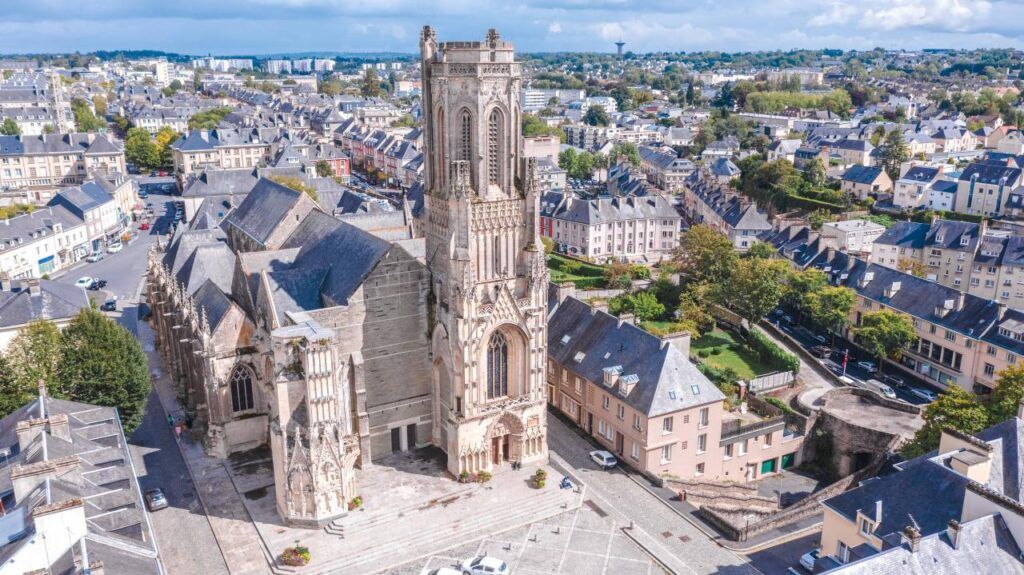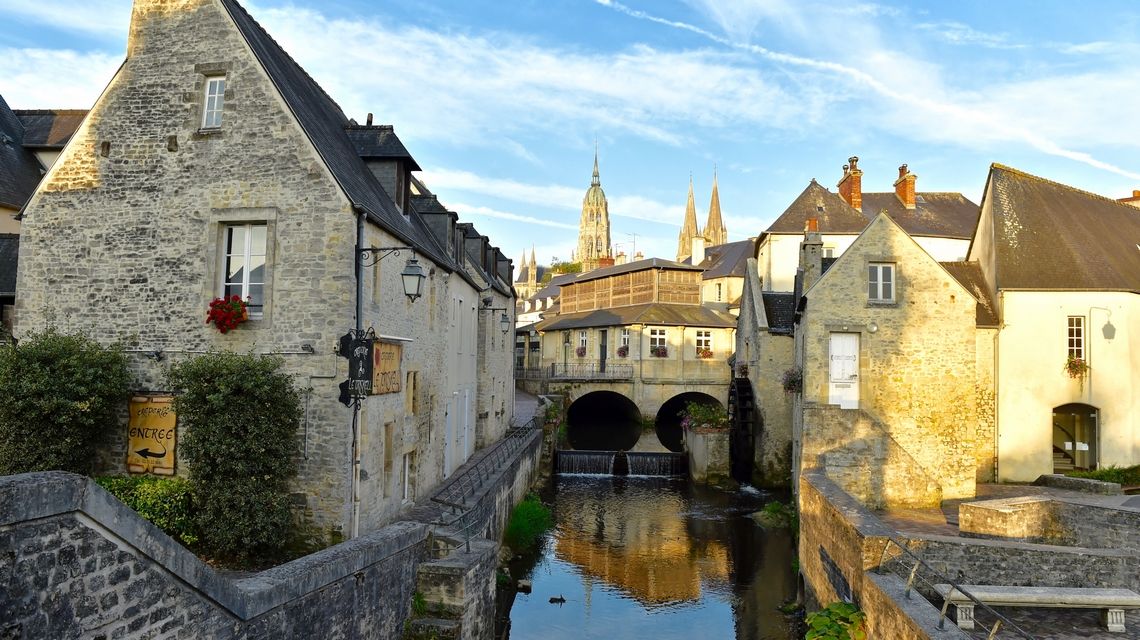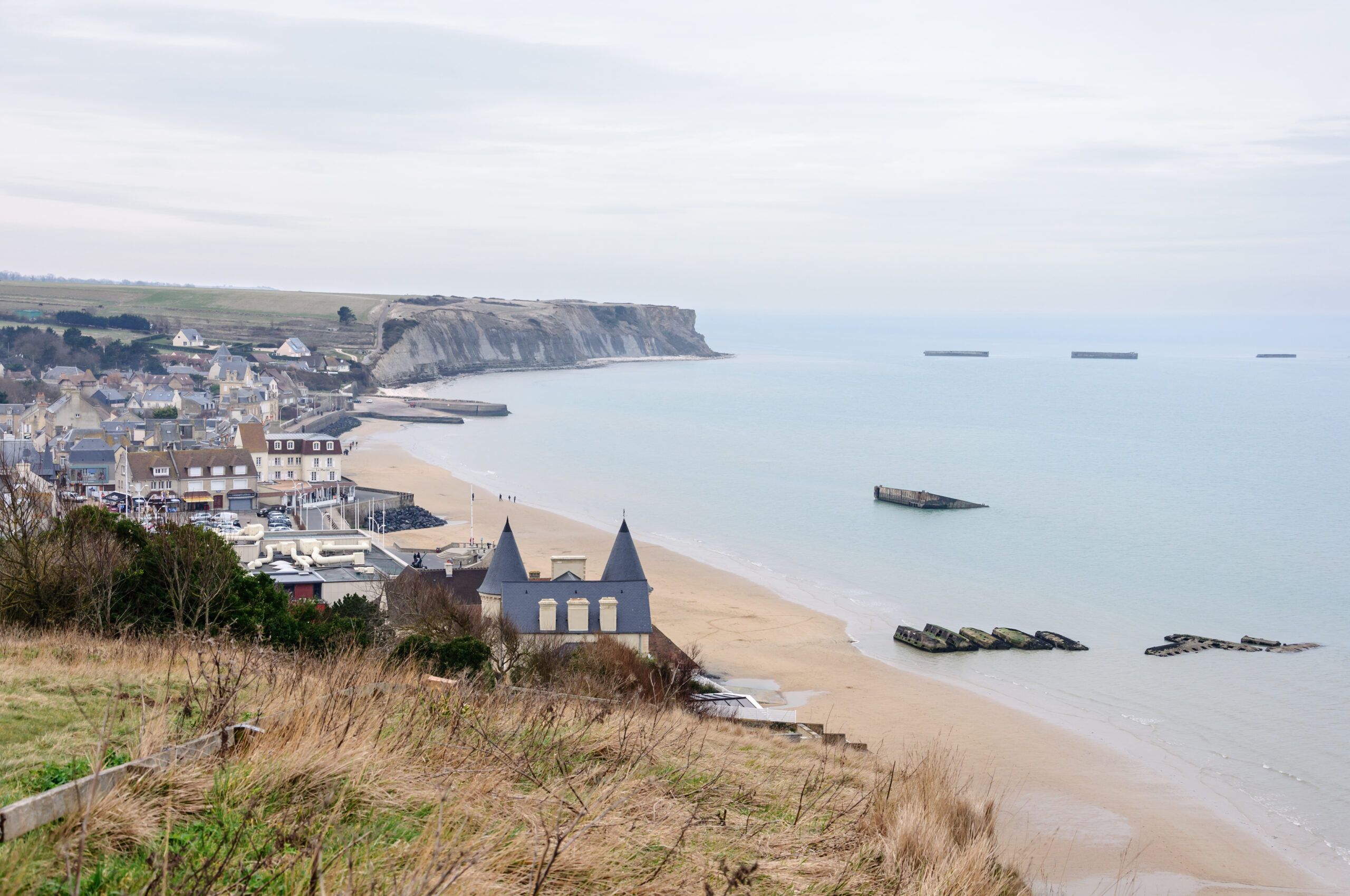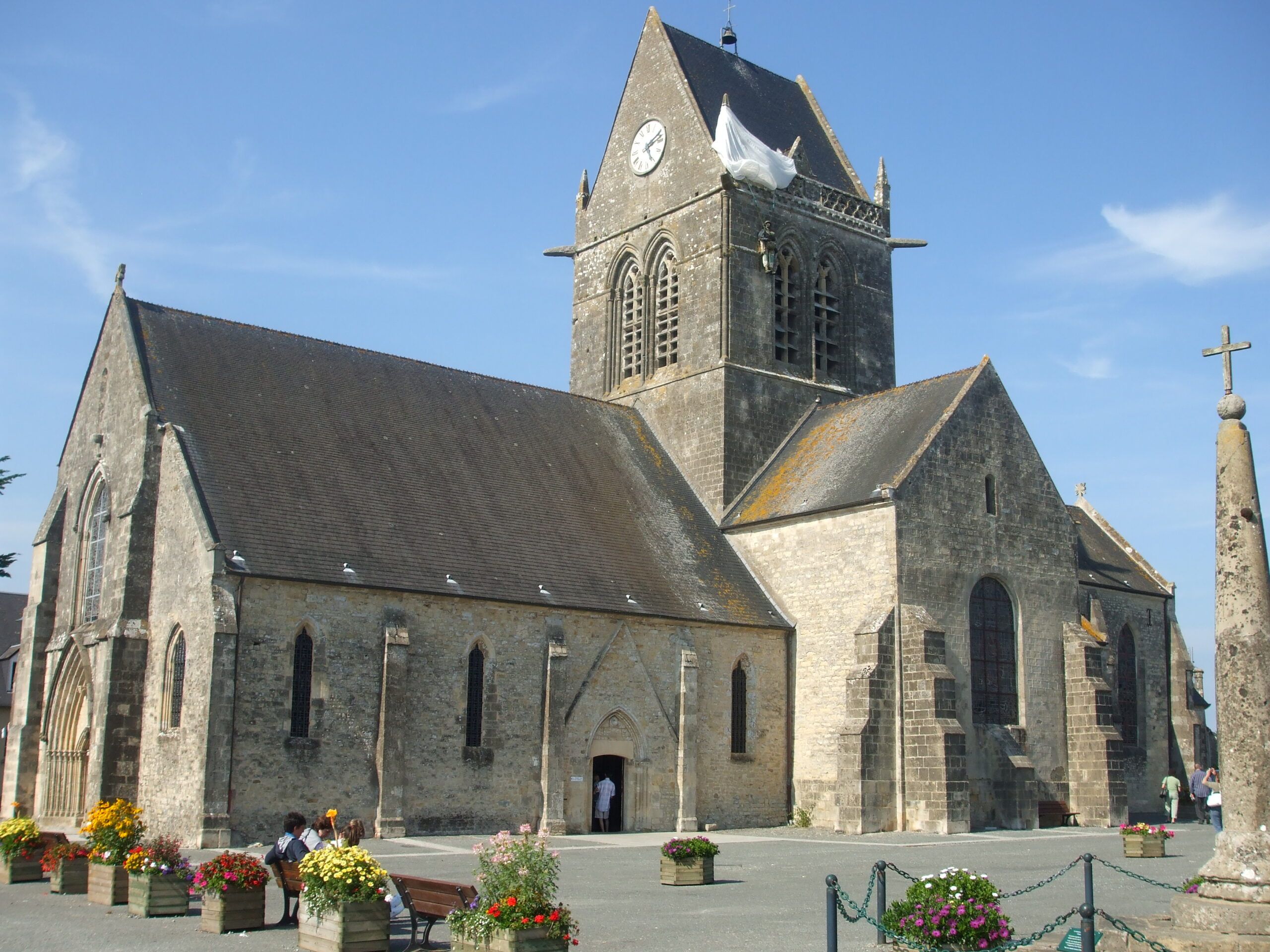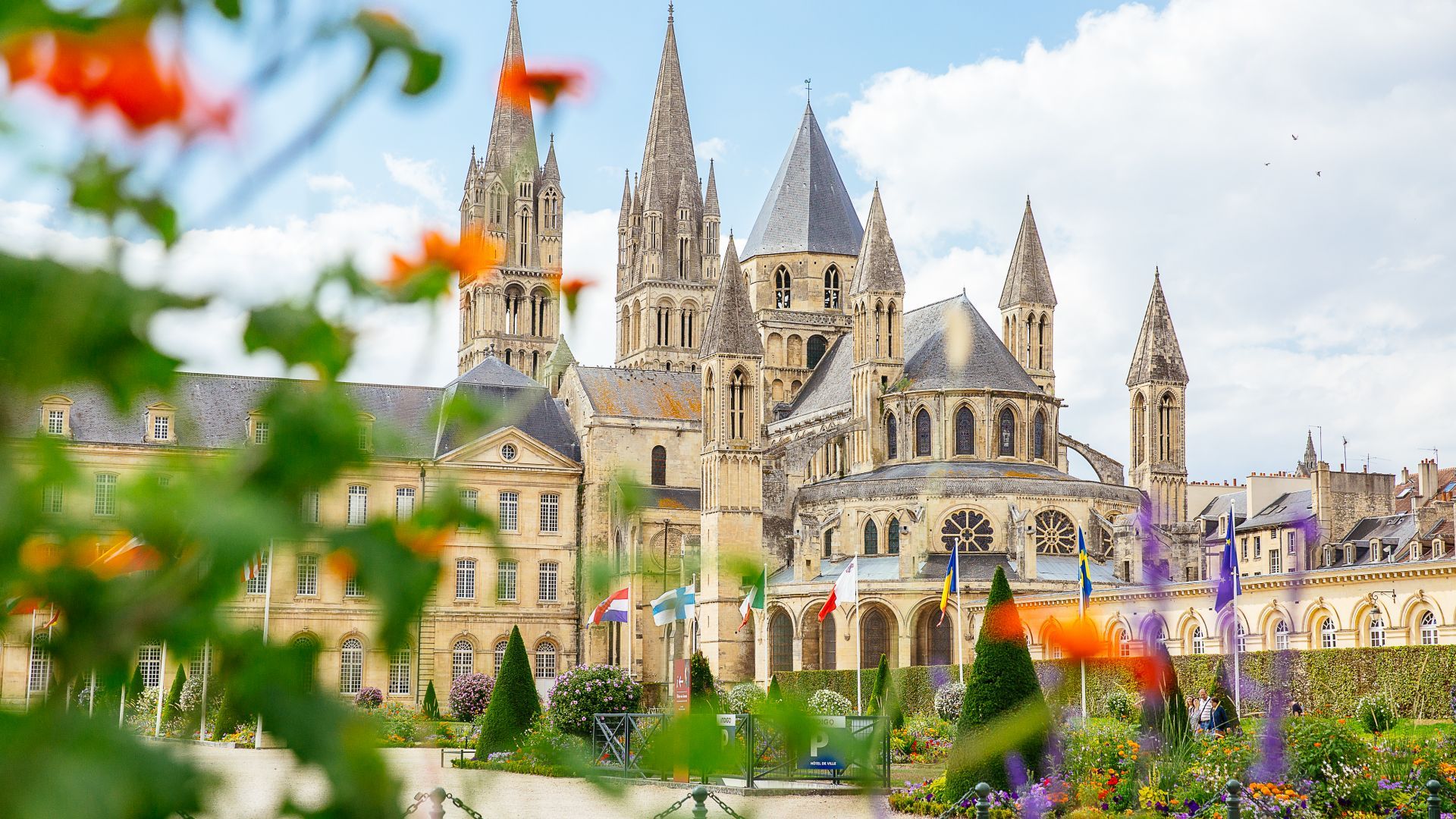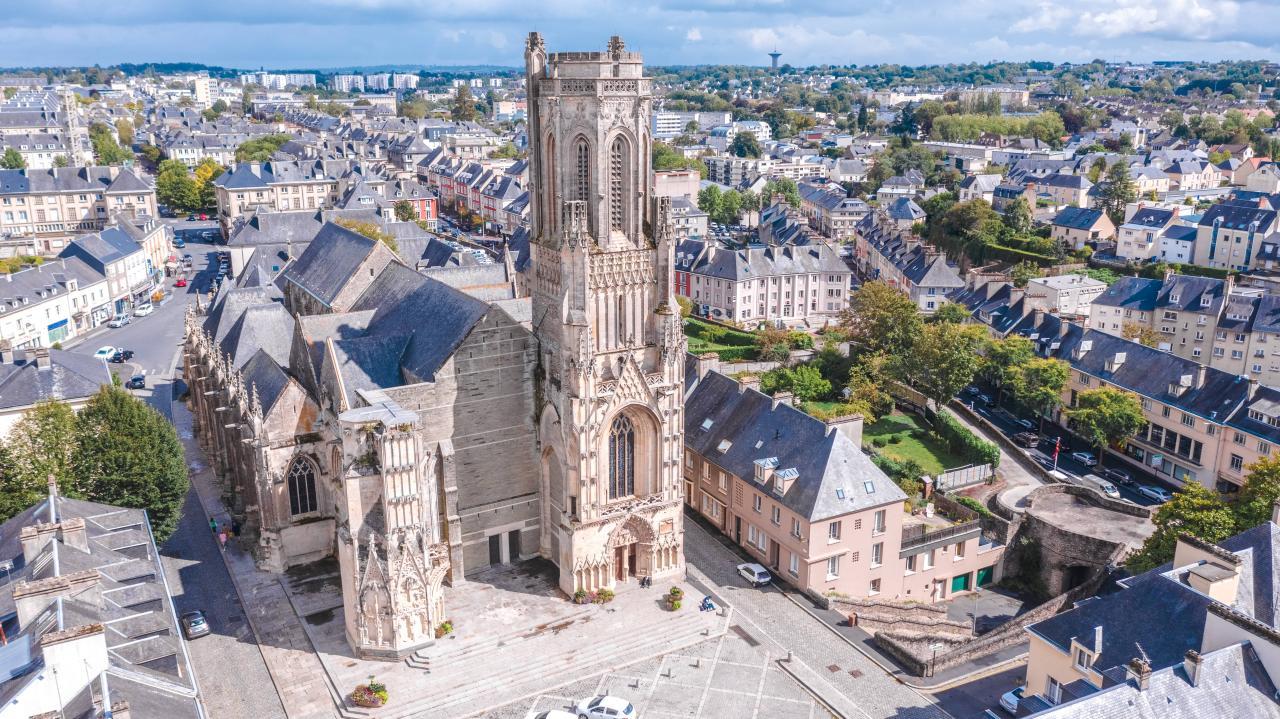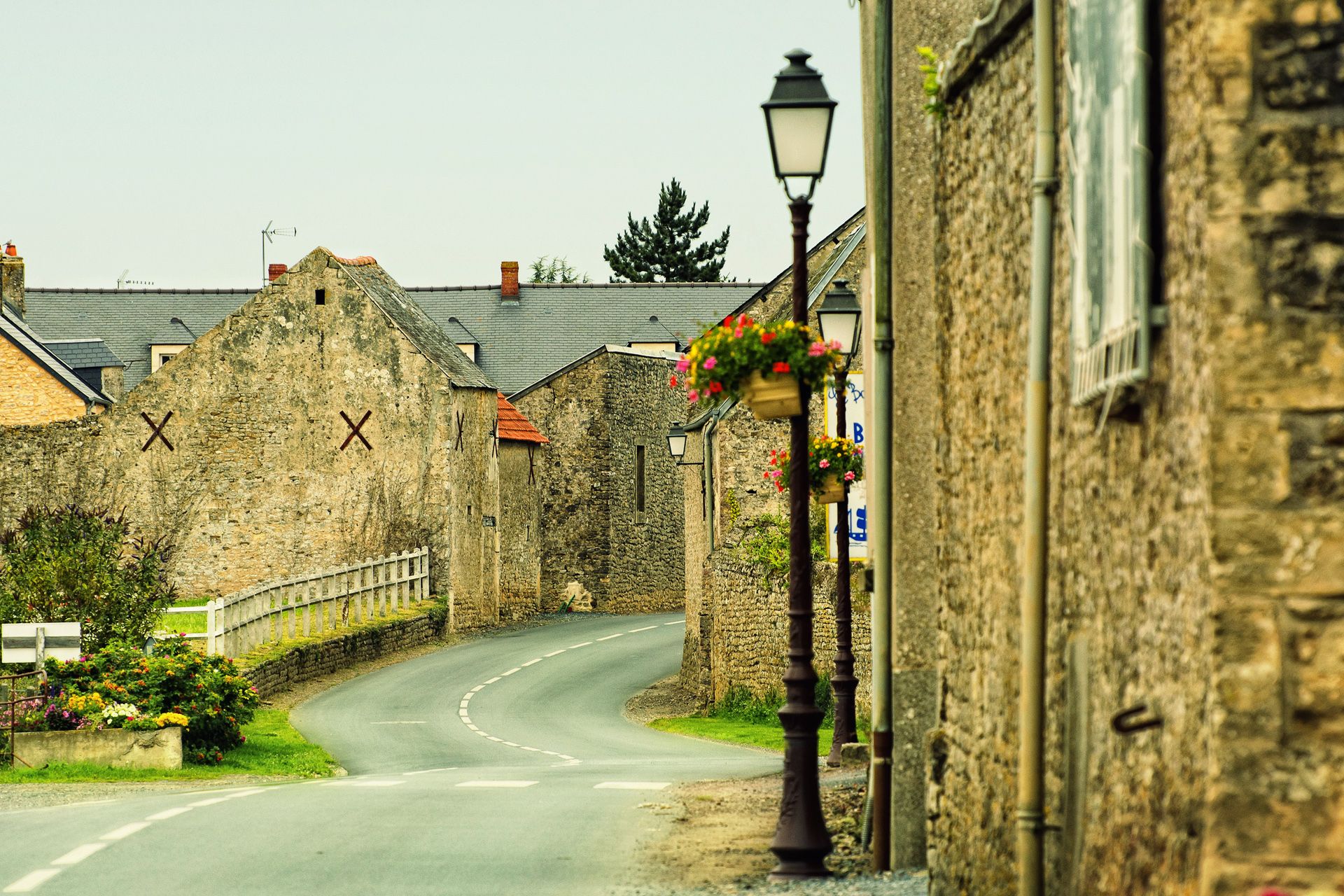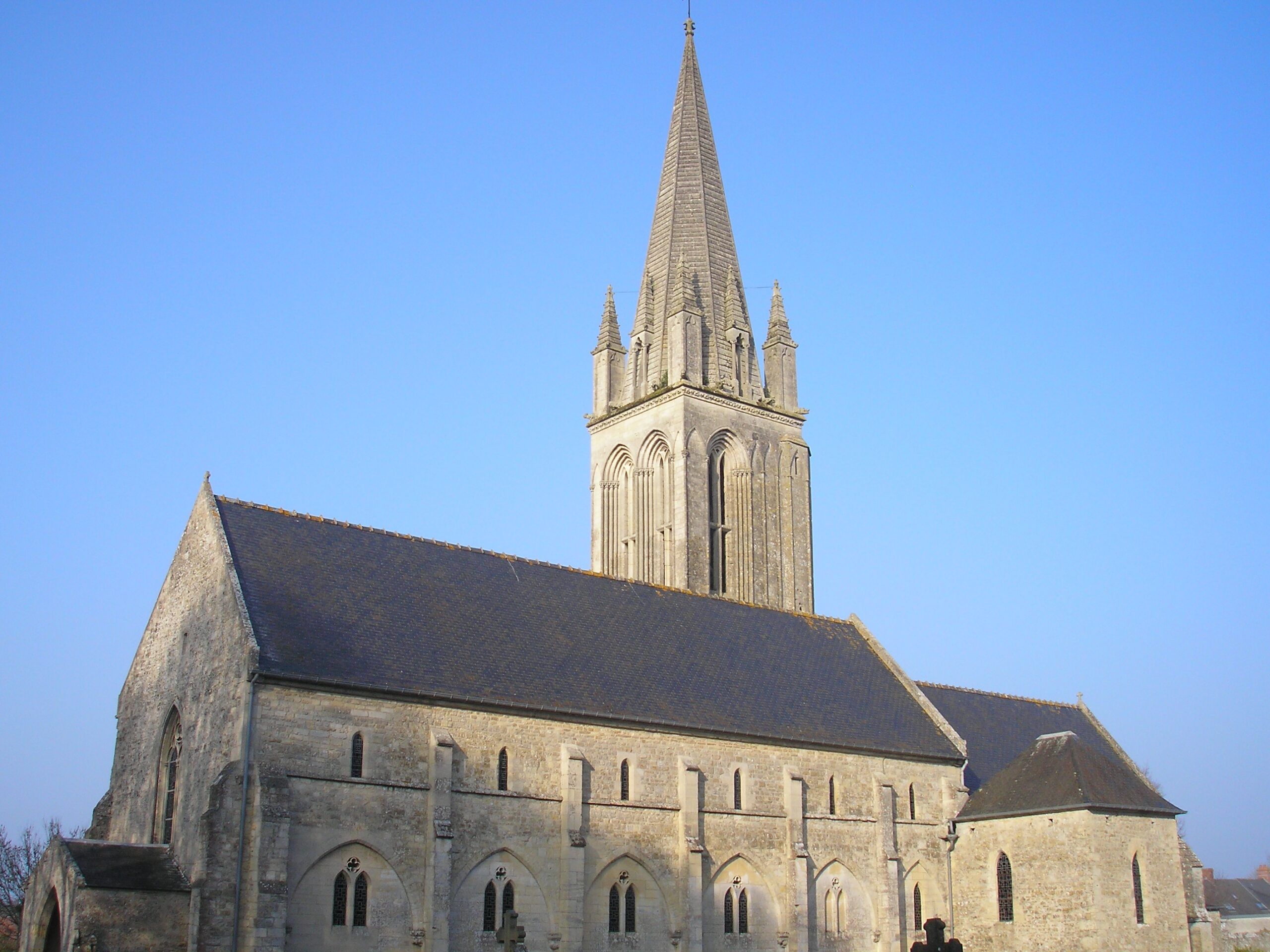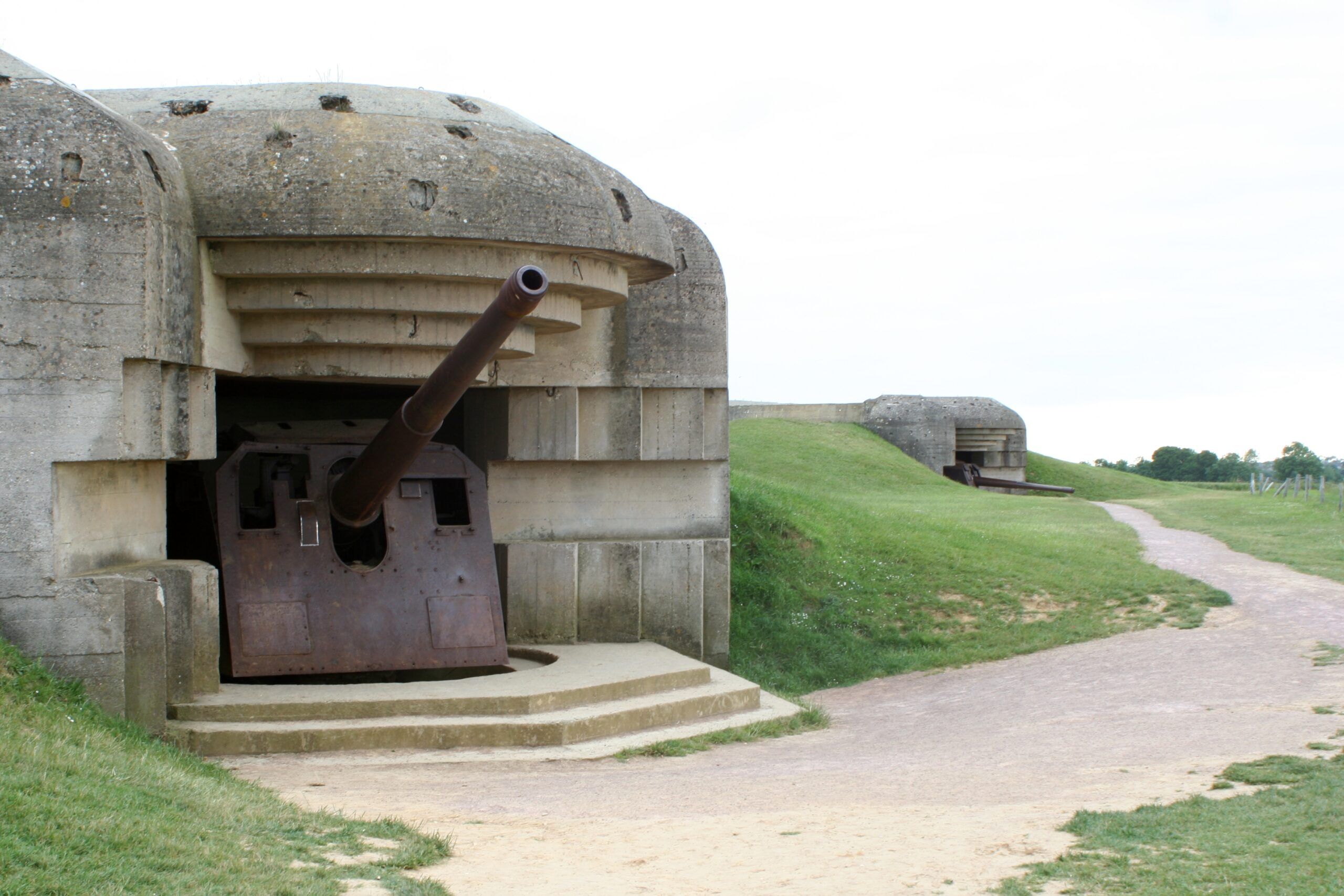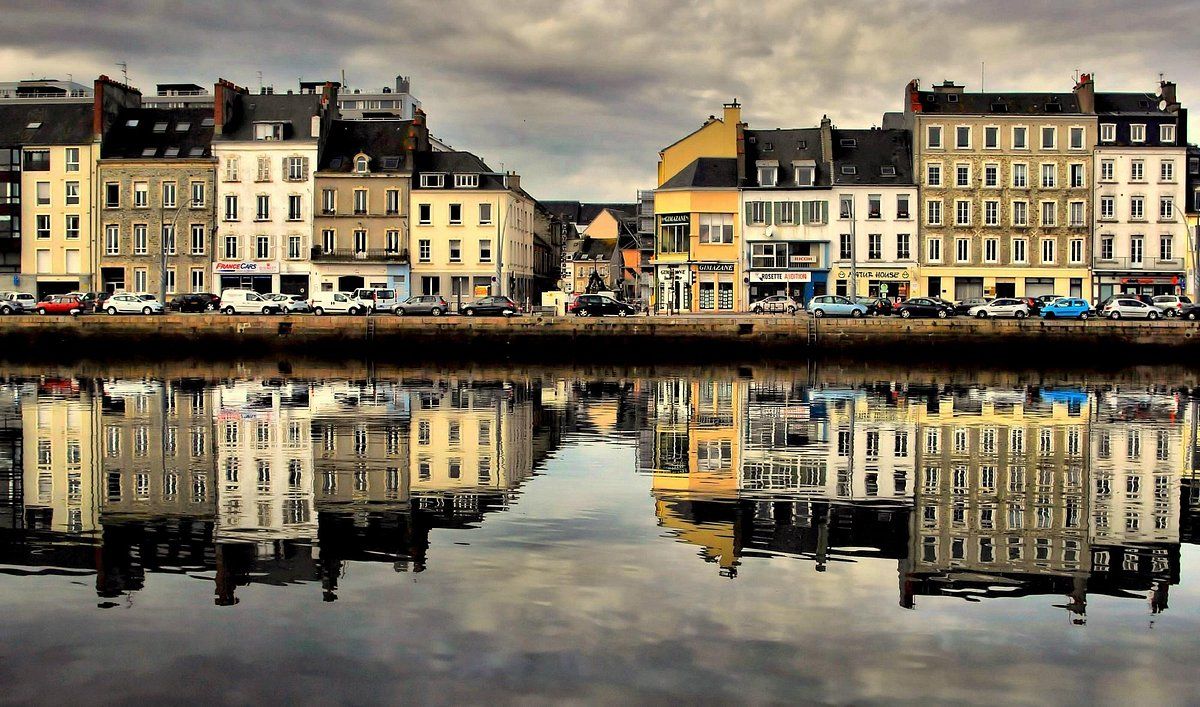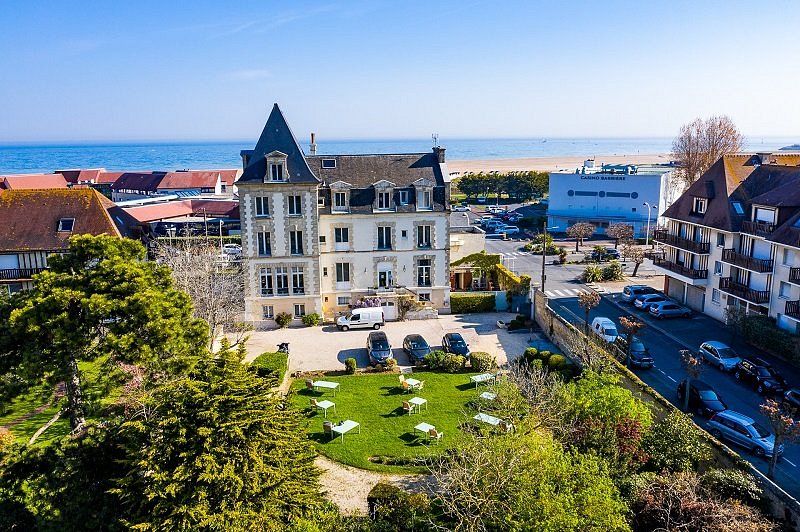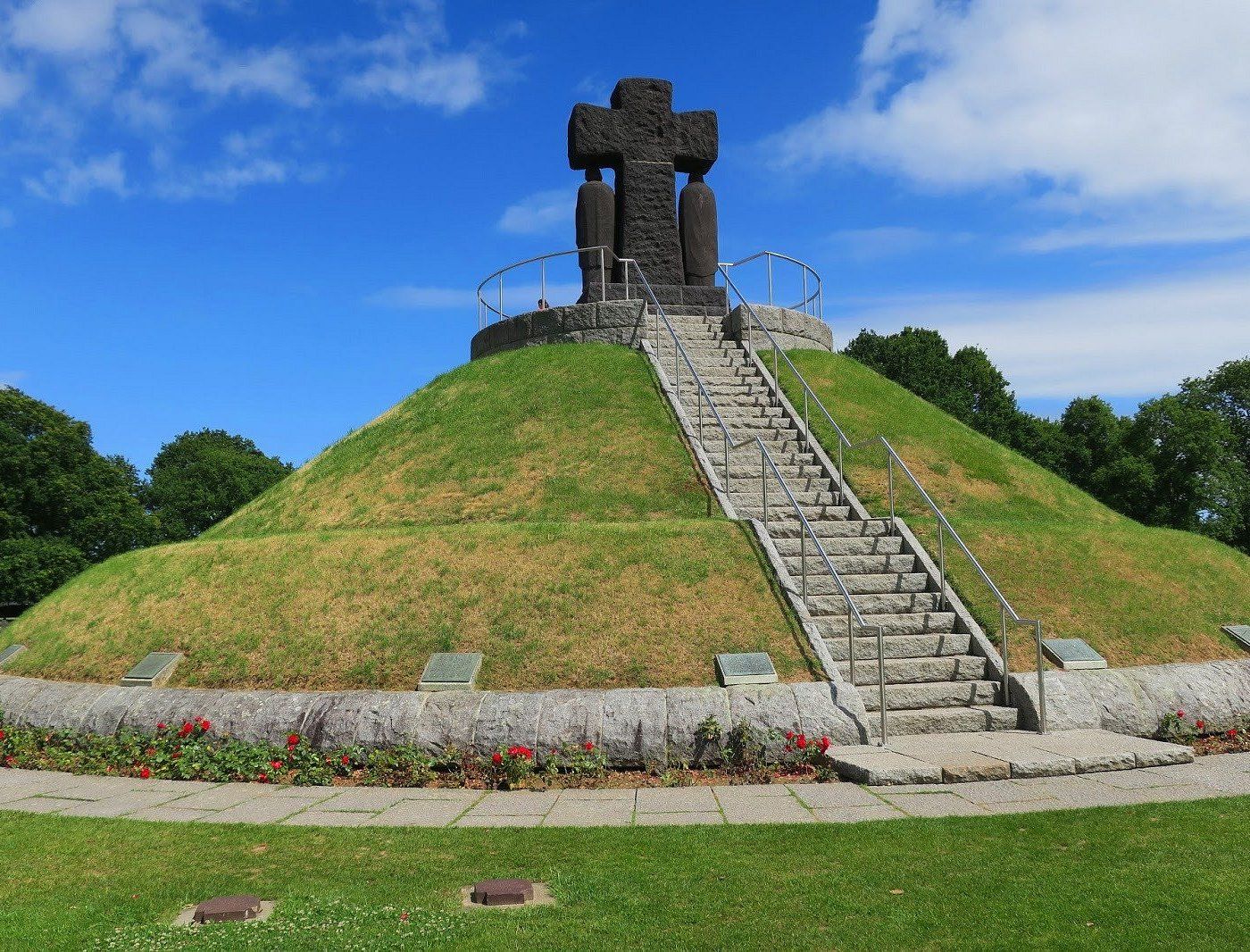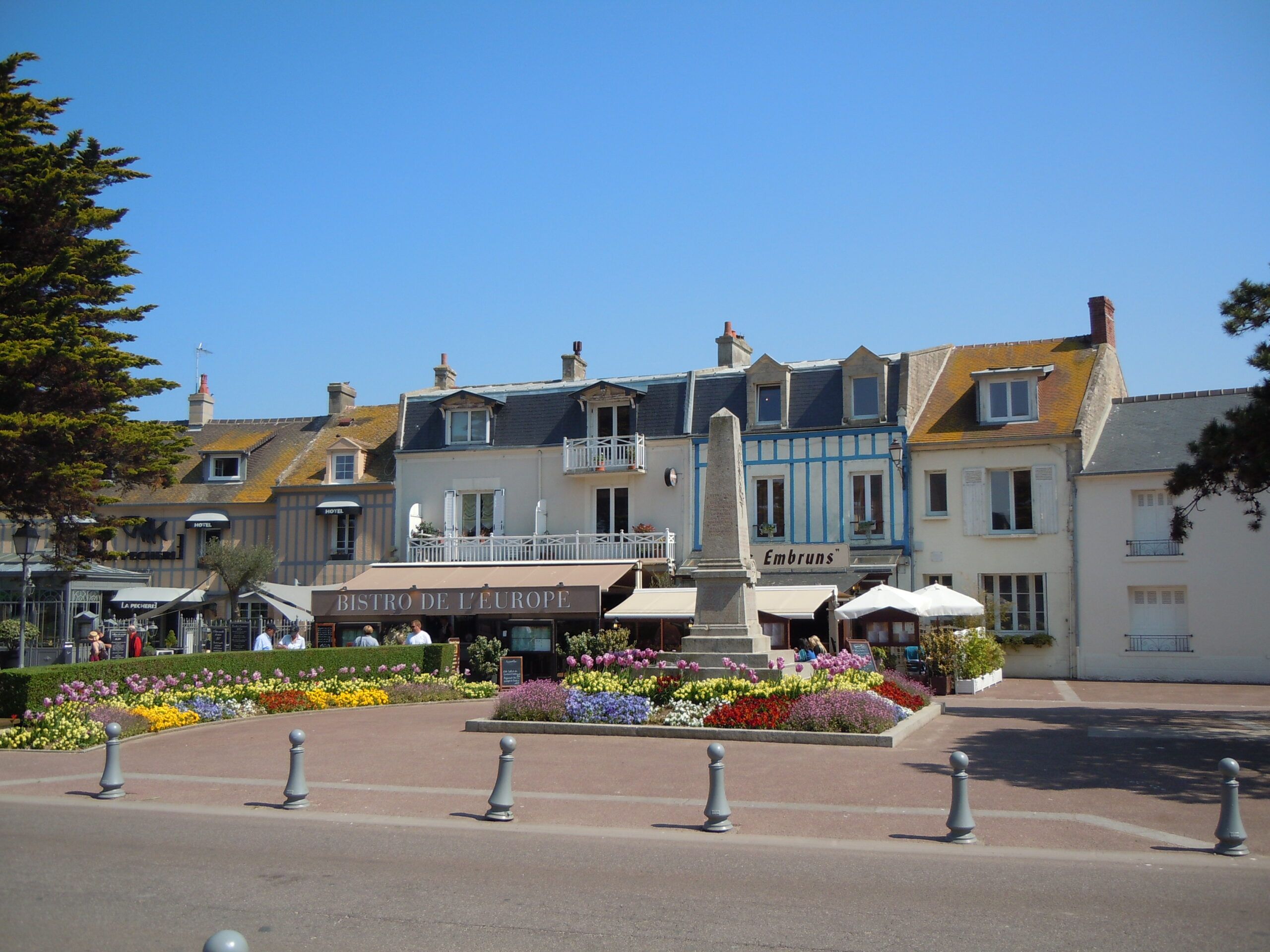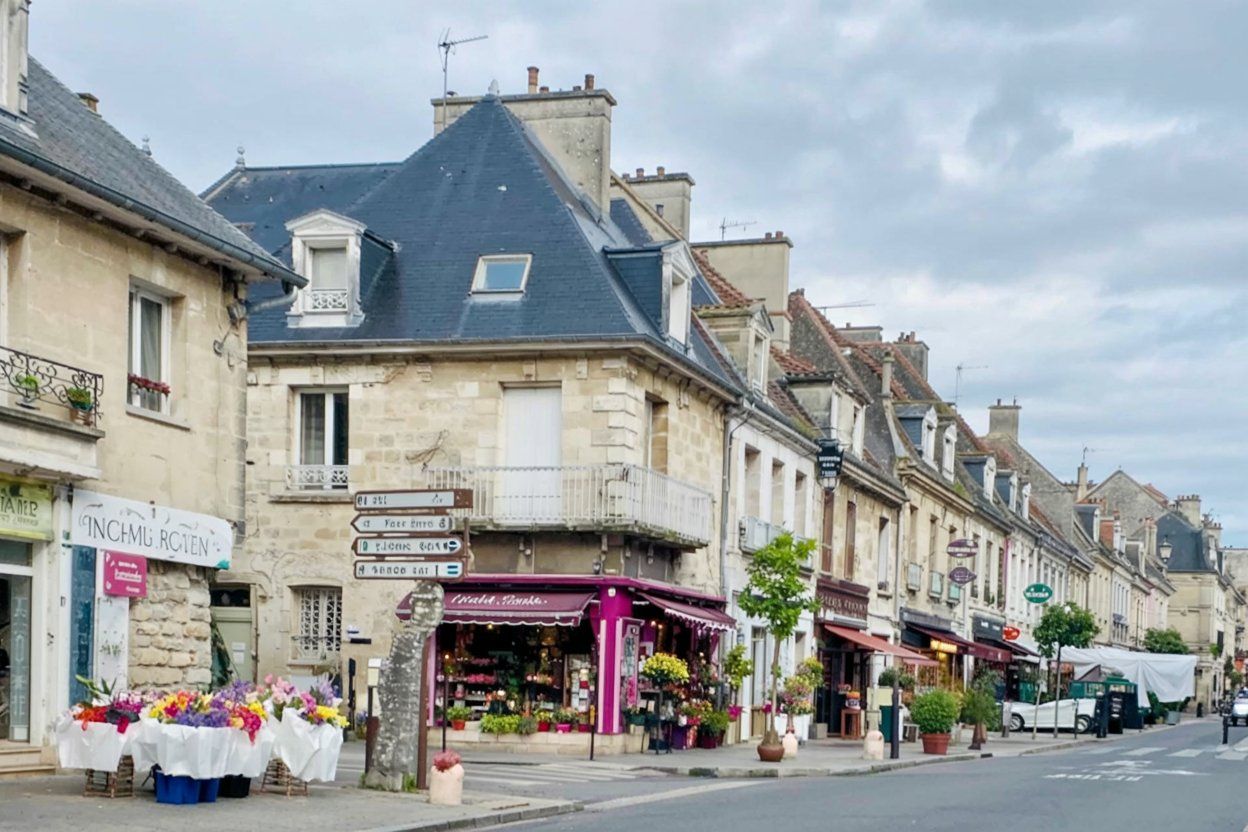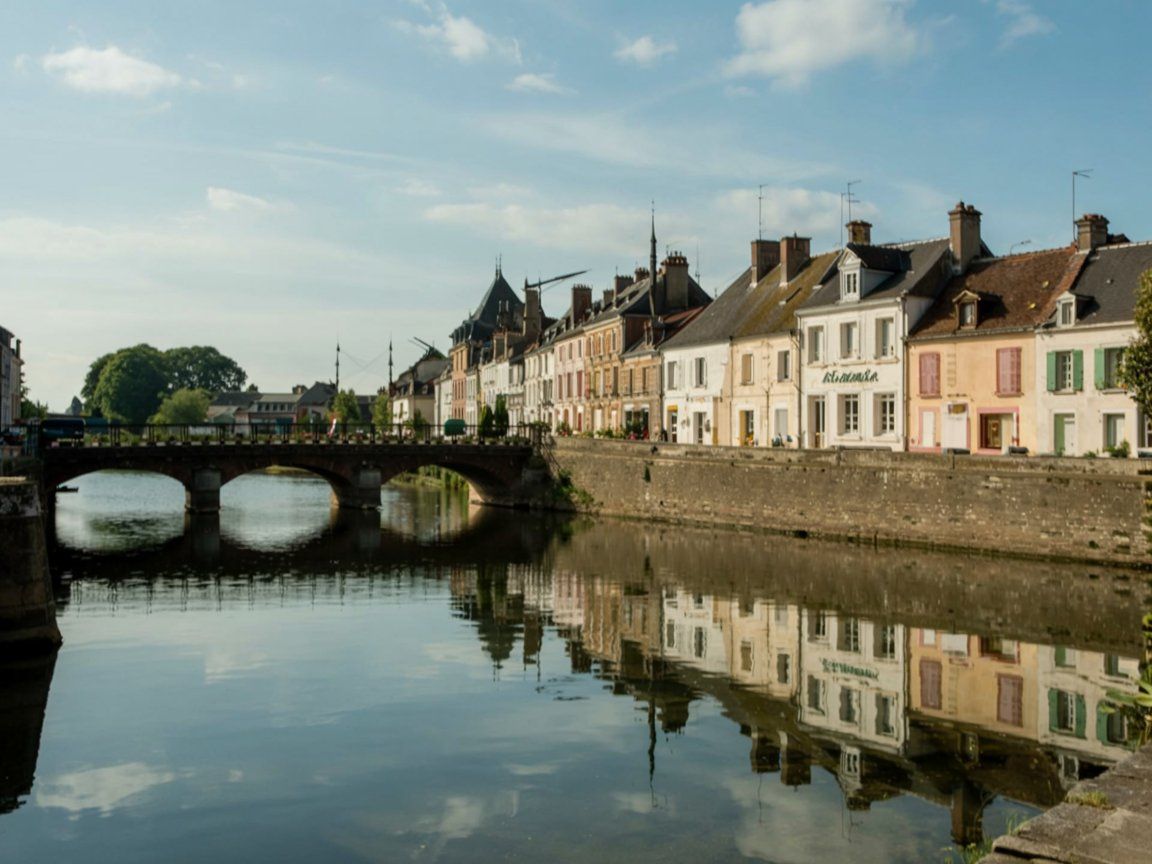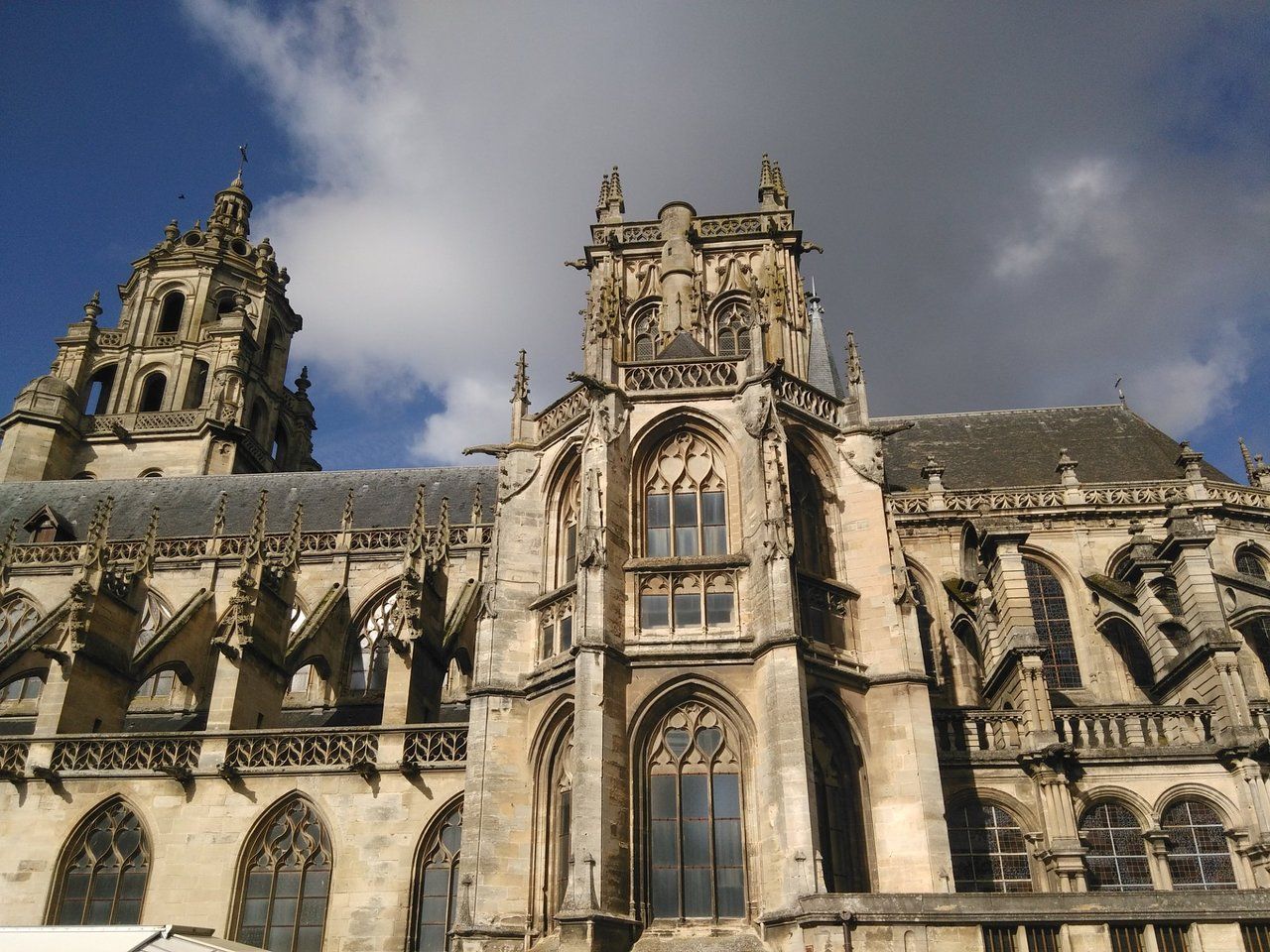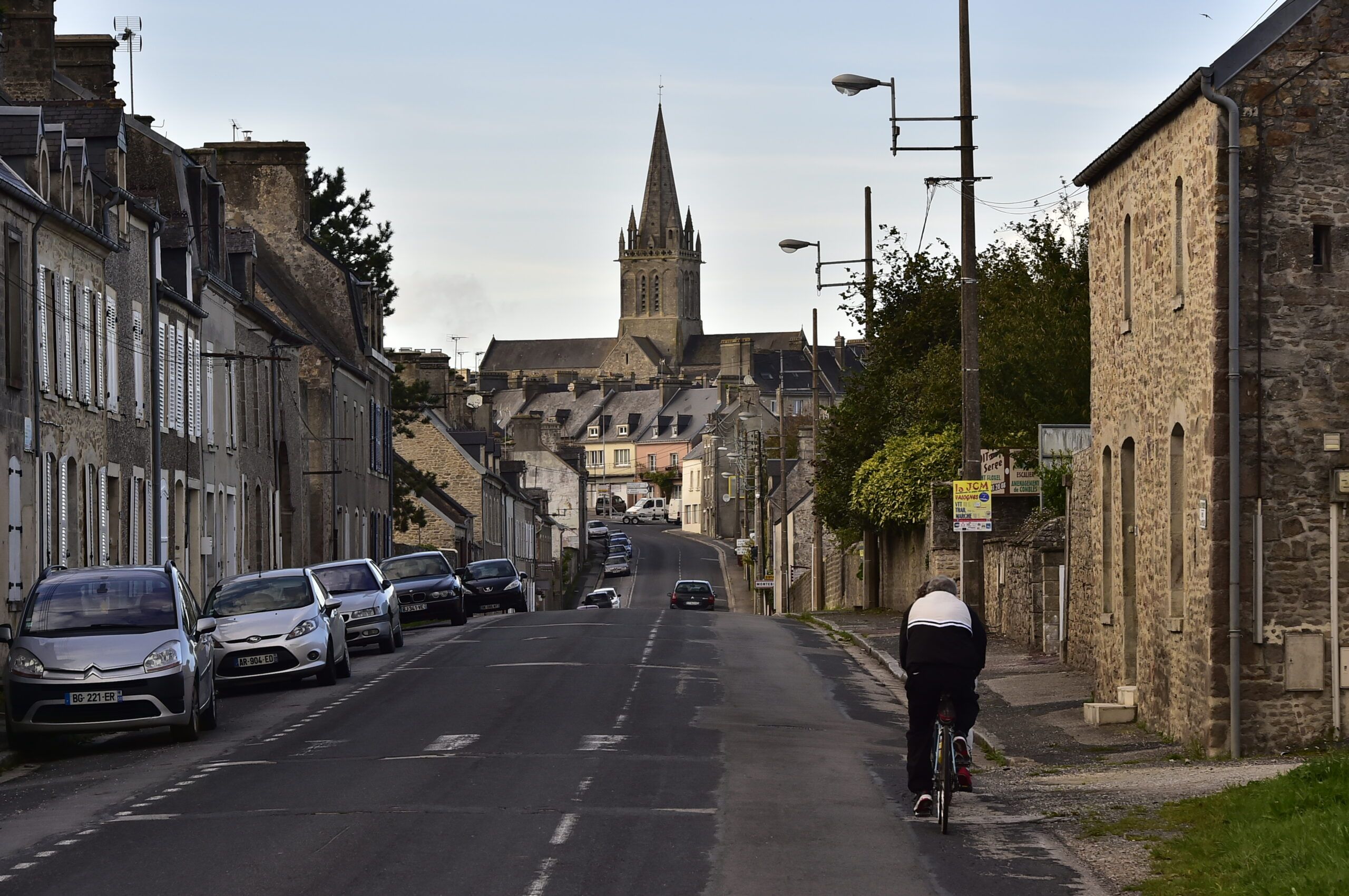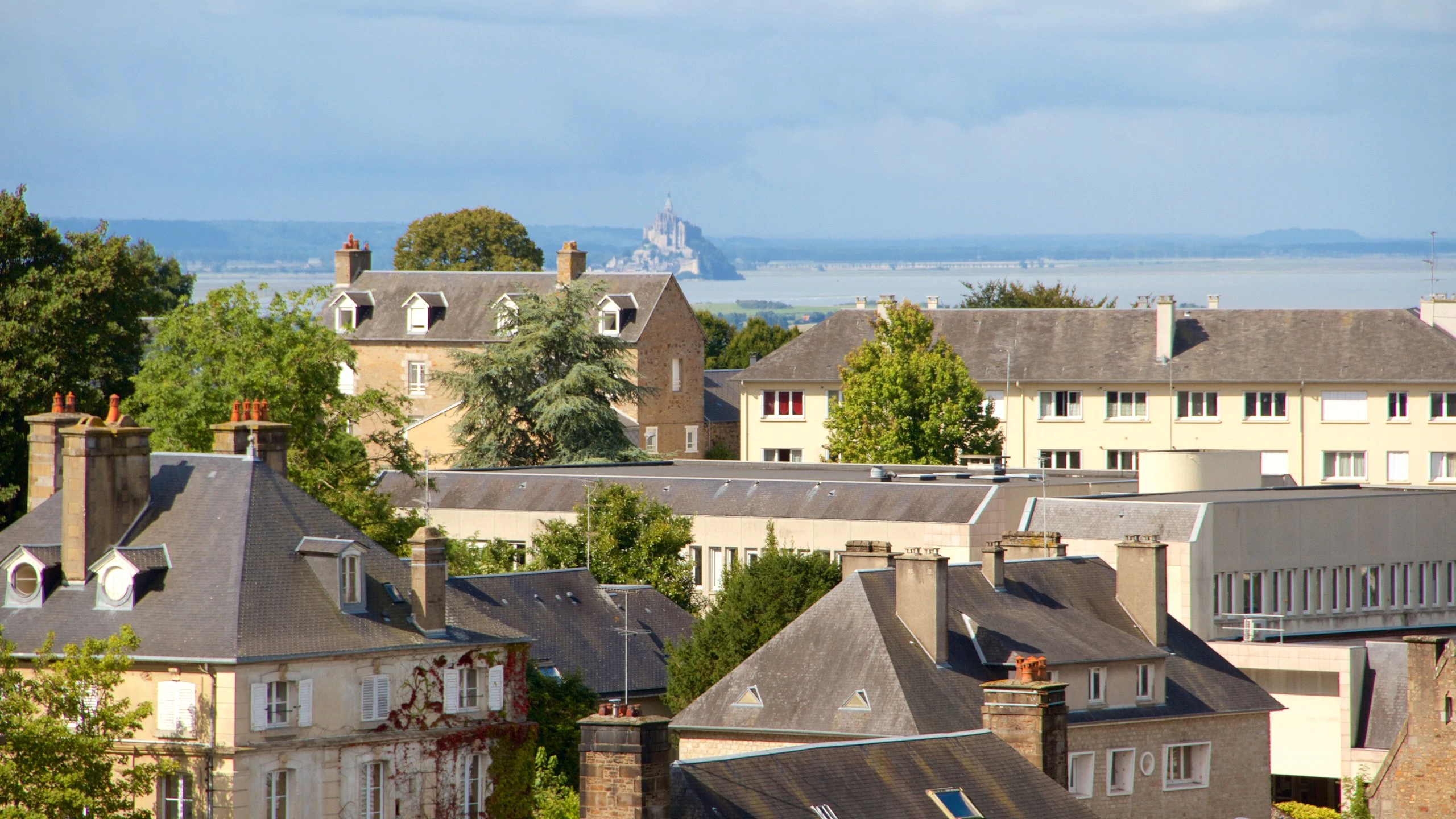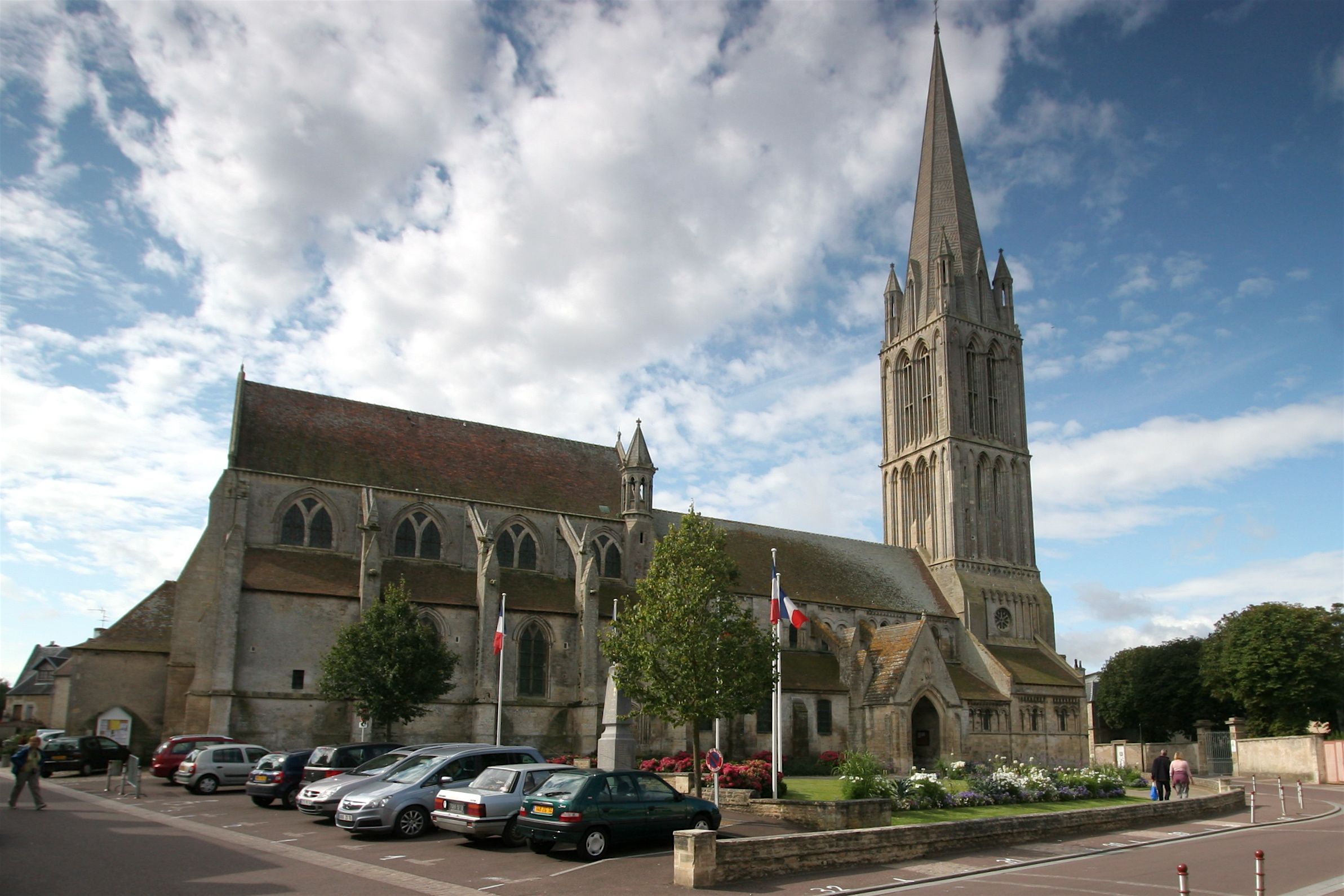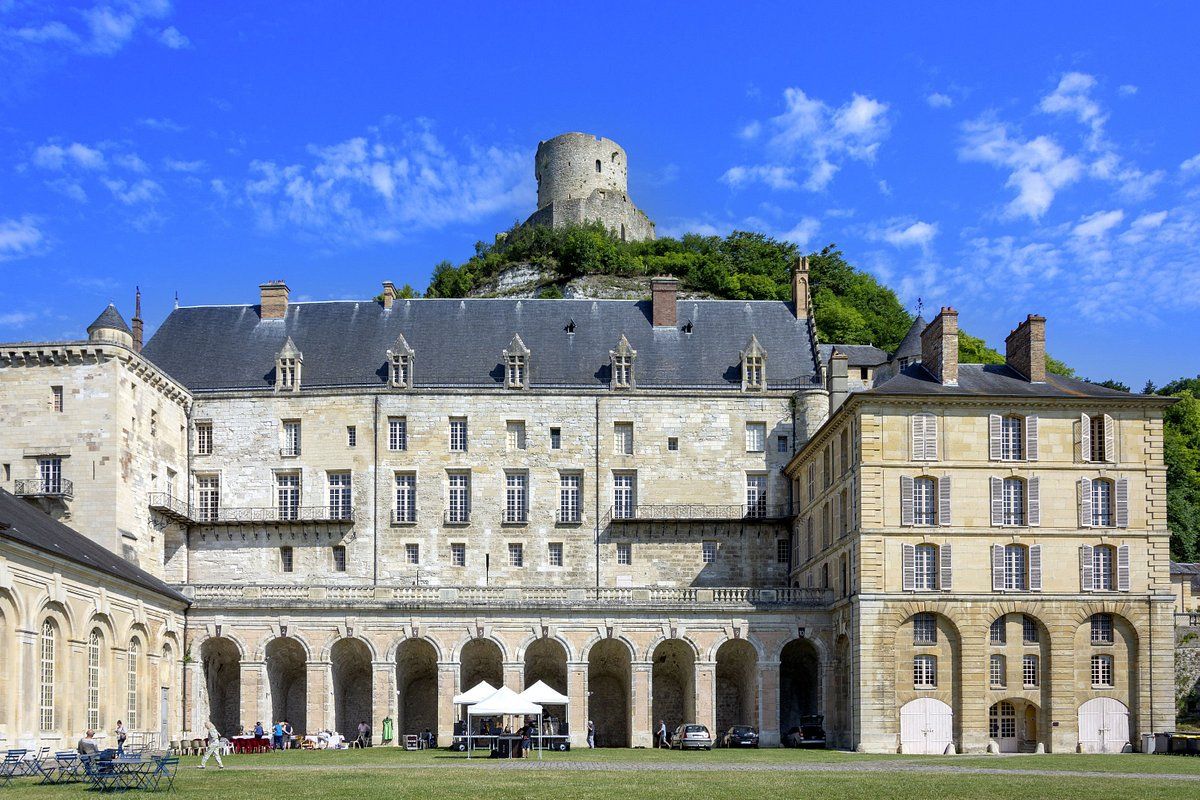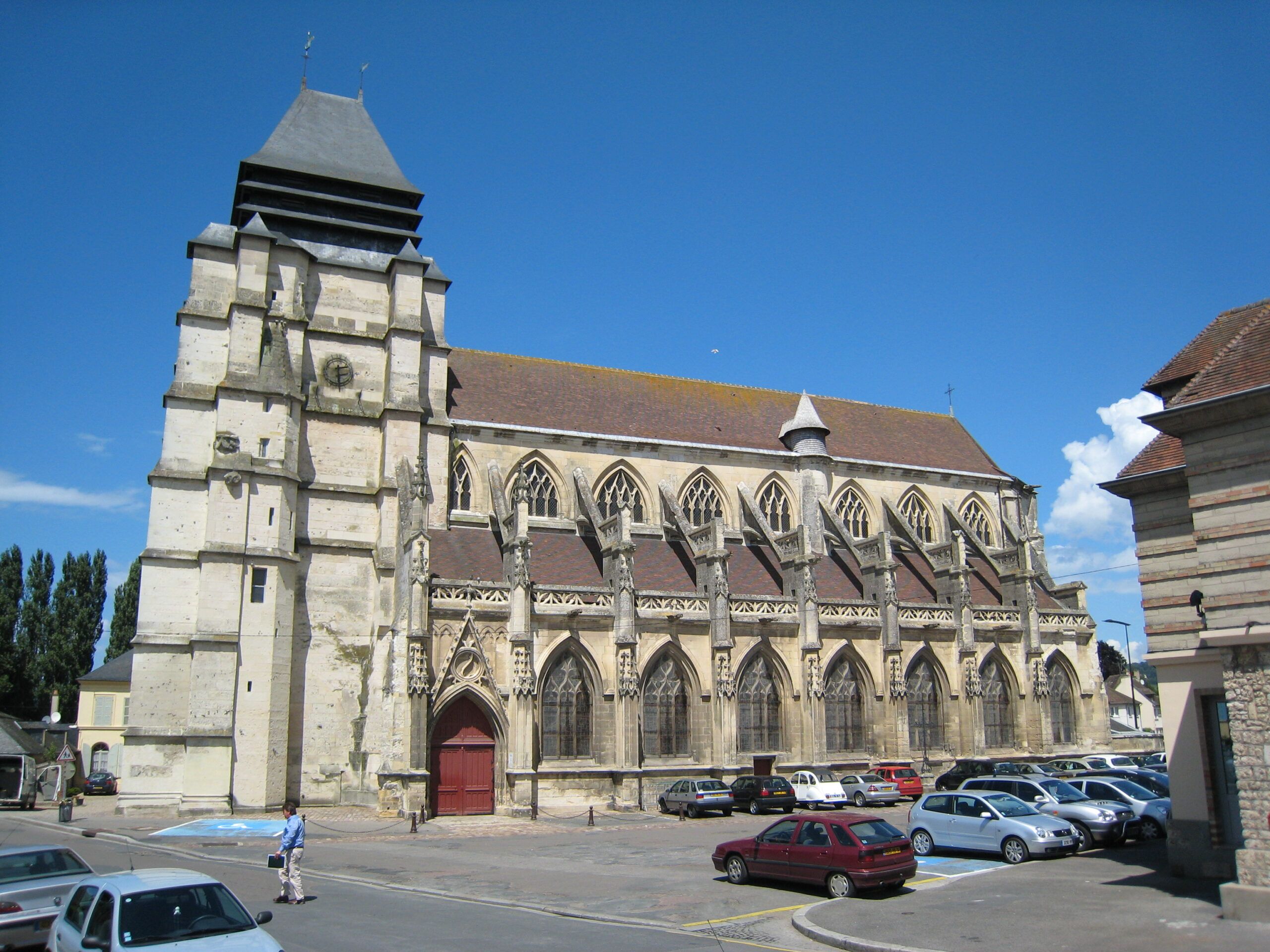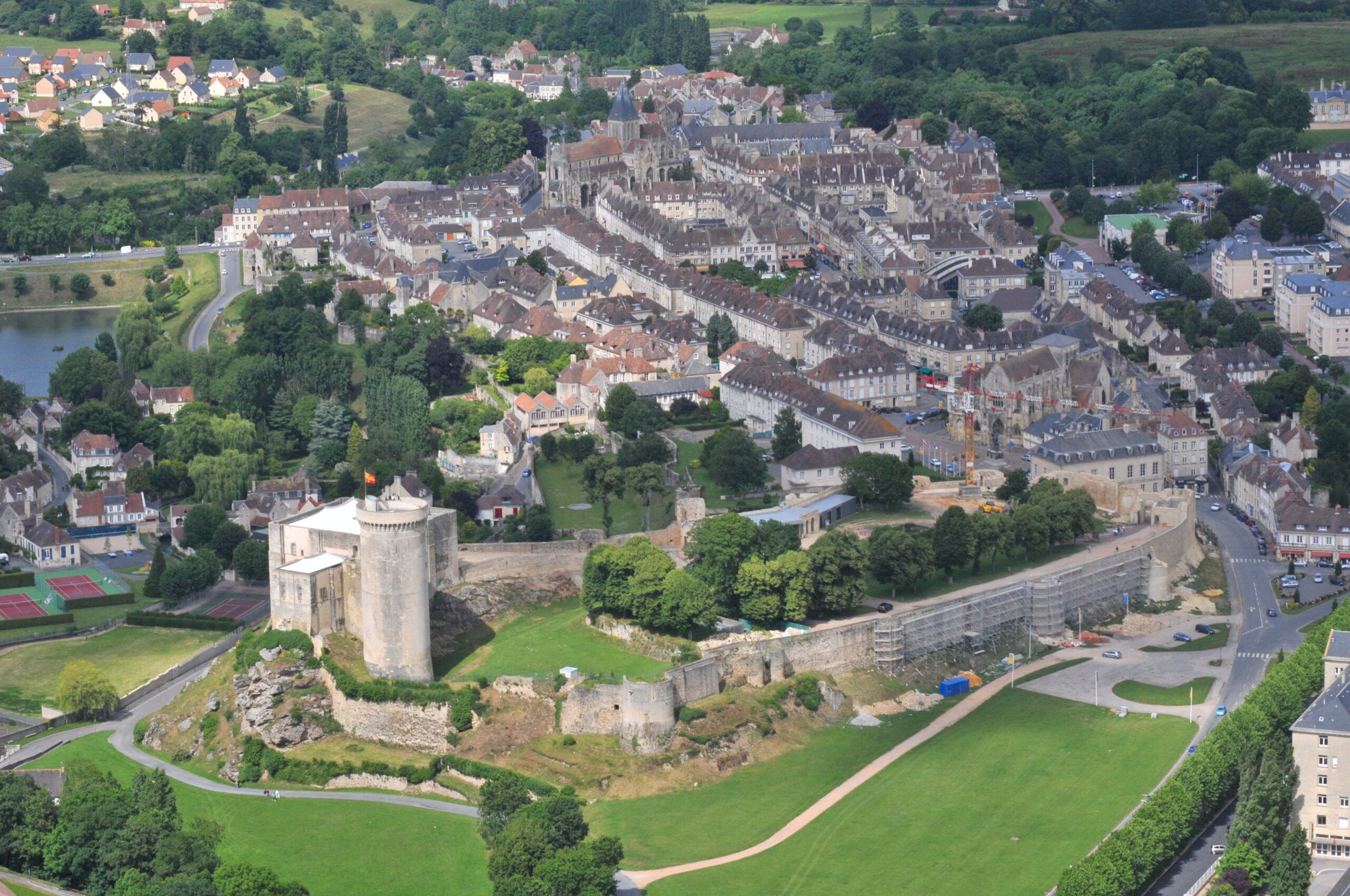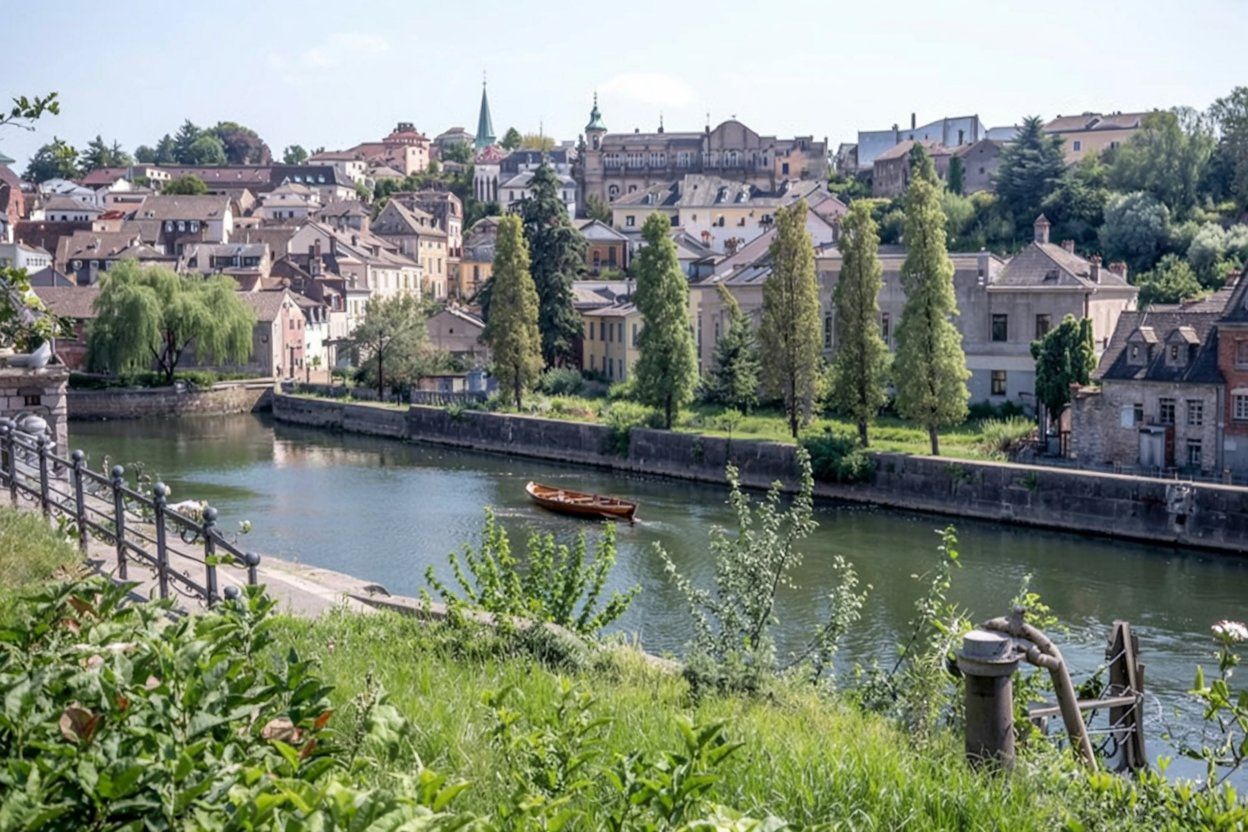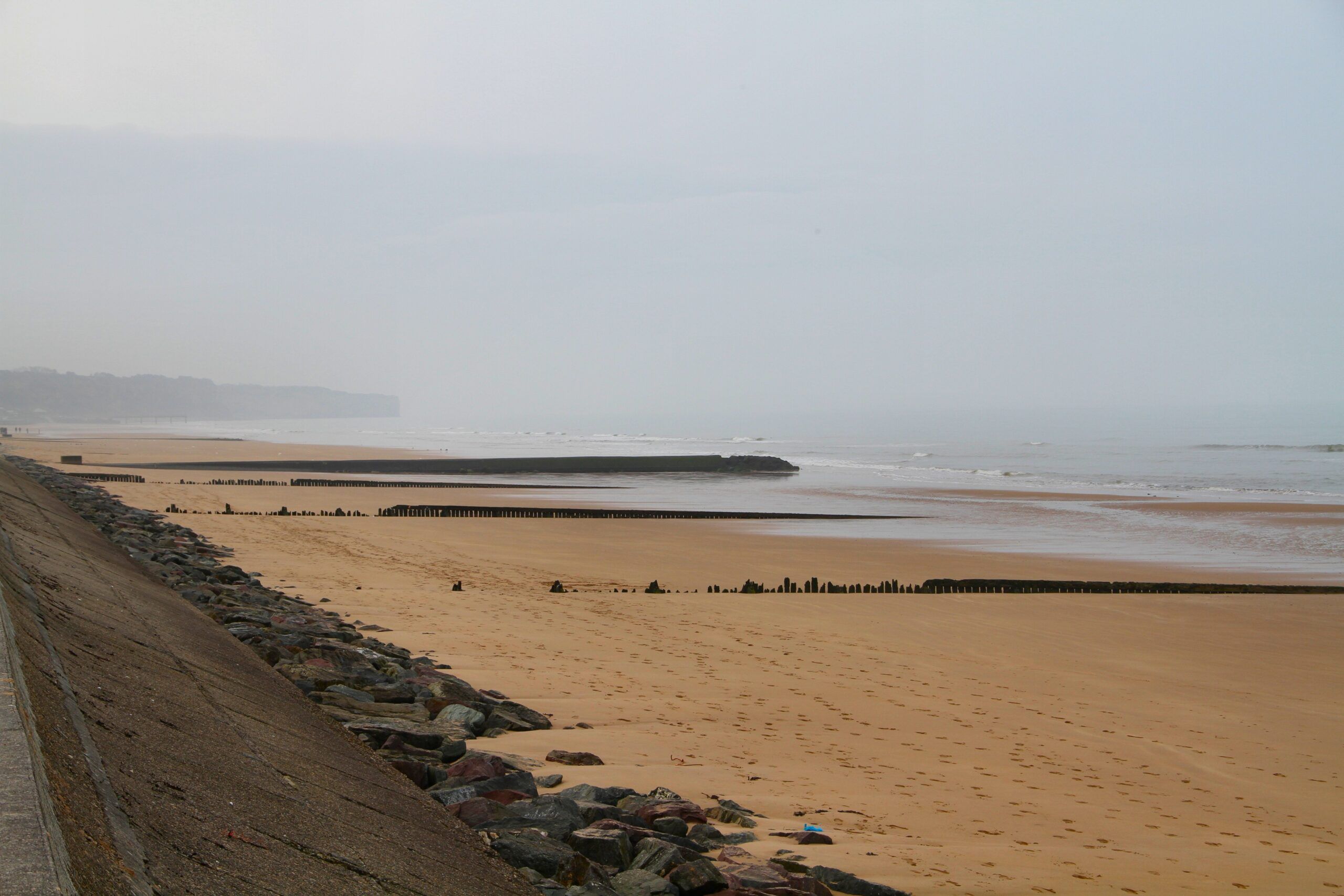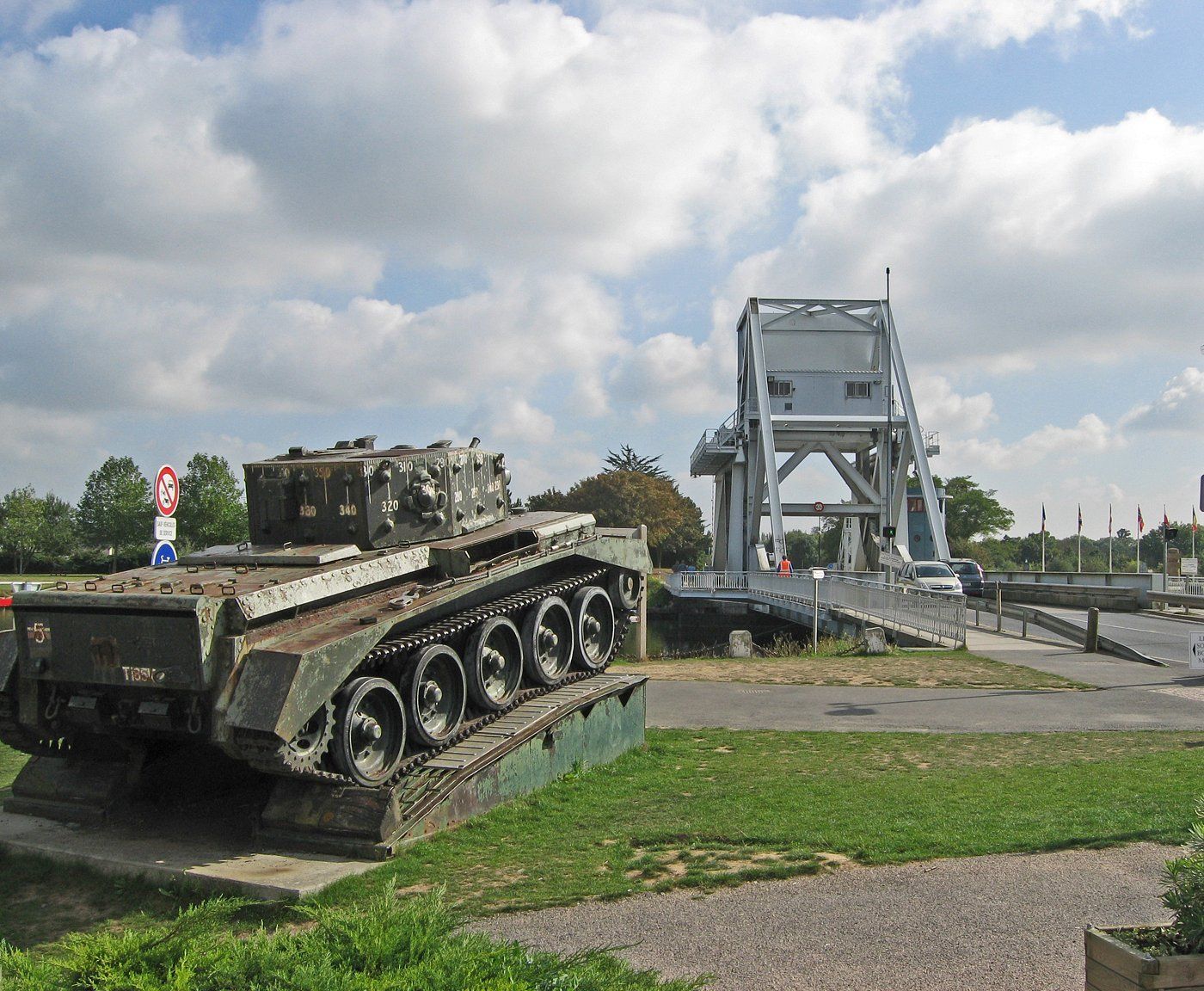Saint-Lô, sometimes called “The Capital of Ruins” after World War II, stands today as both a memorial to wartime sacrifice and a symbol of remarkable renewal. This Norman town saw fierce fighting in July 1944 as American forces, especially the 29th Division, battled German troops after the D-Day landings. The town was almost completely destroyed during these battles, with about 95% of its buildings reduced to rubble as Allied forces fought for this strategic spot.
Now, visitors find a rebuilt city that honors its painful past but fully embraces its present identity as France’s equestrian capital. The new architecture tells a story of resilience, while museums and memorials throughout the area help you understand the town’s pivotal role in the Allied breakthrough. History buffs can trace the path of American GIs who fought house-by-house through the devastated streets before finally securing the town.
Visit Recommended D-Day historic hotels and B&Bs along the invasion beaches.
But Saint-Lô isn’t just about war history. The town’s famous National Stud Farm highlights its proud equestrian heritage, and its location makes it a great base for exploring the region. Whether you’re into WWII history, horses, or just want a less crowded Norman experience, Saint-Lô offers a unique blend of historical significance and contemporary charm.
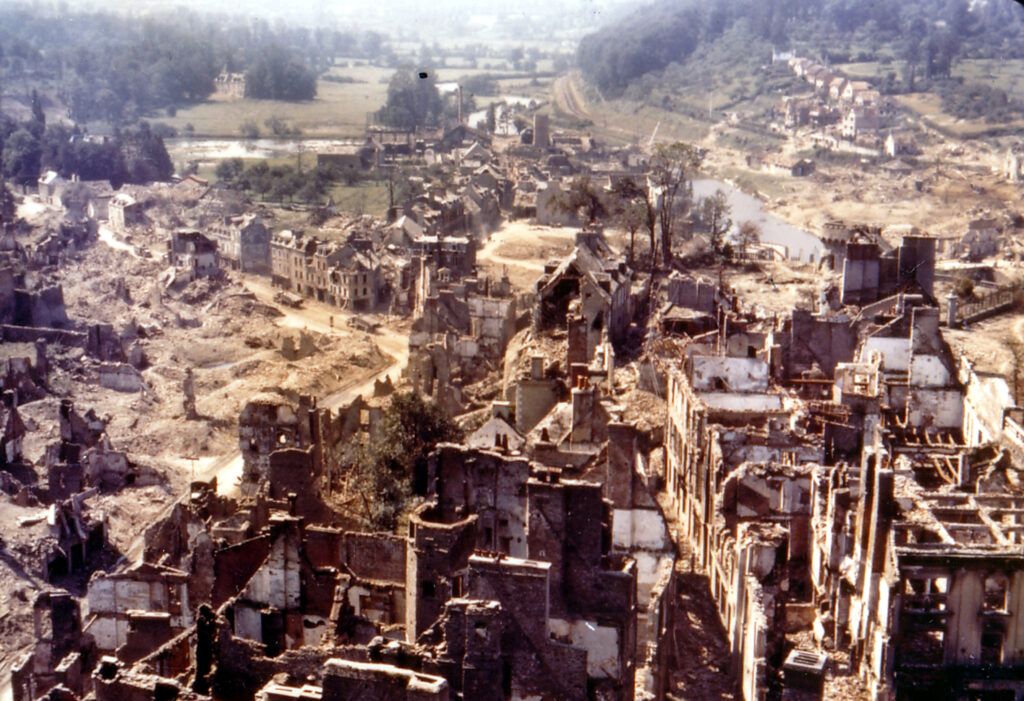
Historical Importance of Saint-Lô in World War II
Saint-Lô played a crucial role during the 1944 Allied campaign to liberate France. Its status as a major transportation hub made it a strategic target, with roads connecting to key destinations throughout Normandy.
D-Day and the Allied Invasion
The Allied invasion of Normandy on June 6, 1944 (D-Day) set the stage for the battle that would later unfold at Saint-Lô. While the first landings happened on beaches codenamed Utah, Omaha, Gold, Juno, and Sword, Saint-Lô was picked as a key inland goal.
American paratroopers from the 82nd and 101st Airborne Divisions dropped behind enemy lines the night before D-Day. Their mission included securing roads and bridges leading toward Saint-Lô to keep German reinforcements from reaching the beaches.
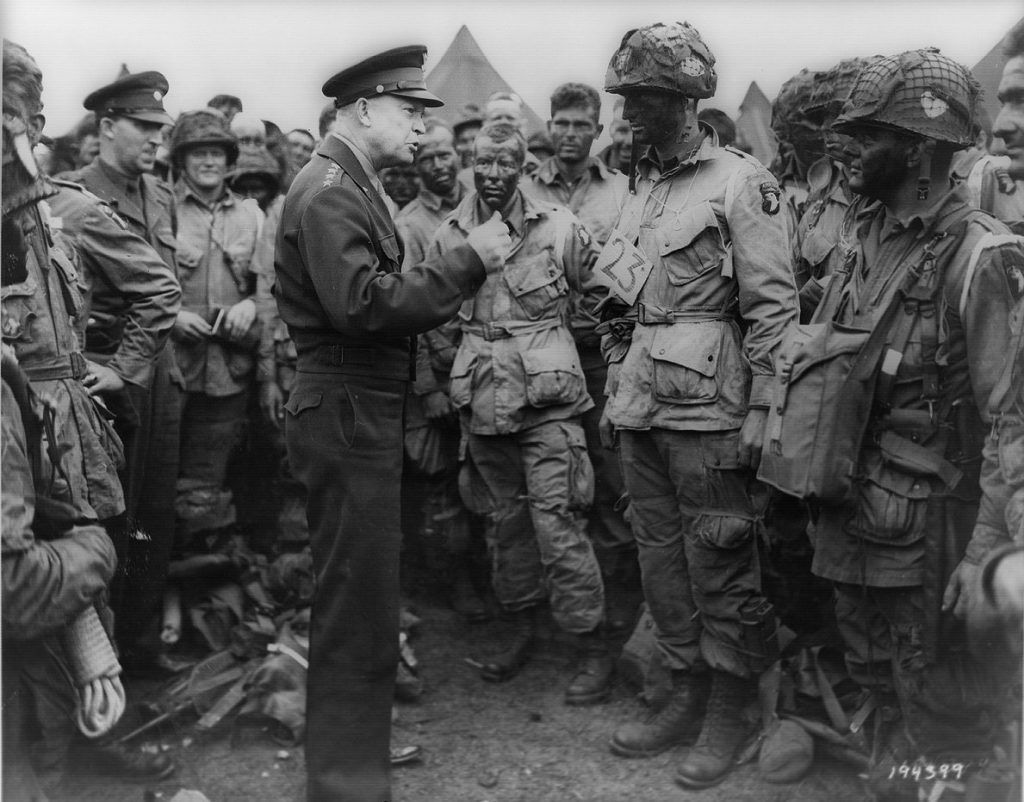
The town’s value came from its spot at the junction of several major roads. Controlling Saint-Lô let the Allies move more freely through the Normandy countryside and keep pushing toward Paris.
As Allied forces moved inland, they ran into the tough Norman bocage (hedgerow) landscape around Saint-Lô. These dense hedgerows gave German troops ready-made defensive positions.
The Battle for Saint-Lô
The fight for Saint-Lô turned into one of the bloodiest chapters of the Normandy campaign. American forces, mainly from the 29th and 35th Infantry Divisions, met fierce German resistance as they closed in on the town.
The battle became infamous for its hedgerow fighting. Tall earthen banks topped with hedges slowed the Allied advance and gave cover to German troops and artillery.
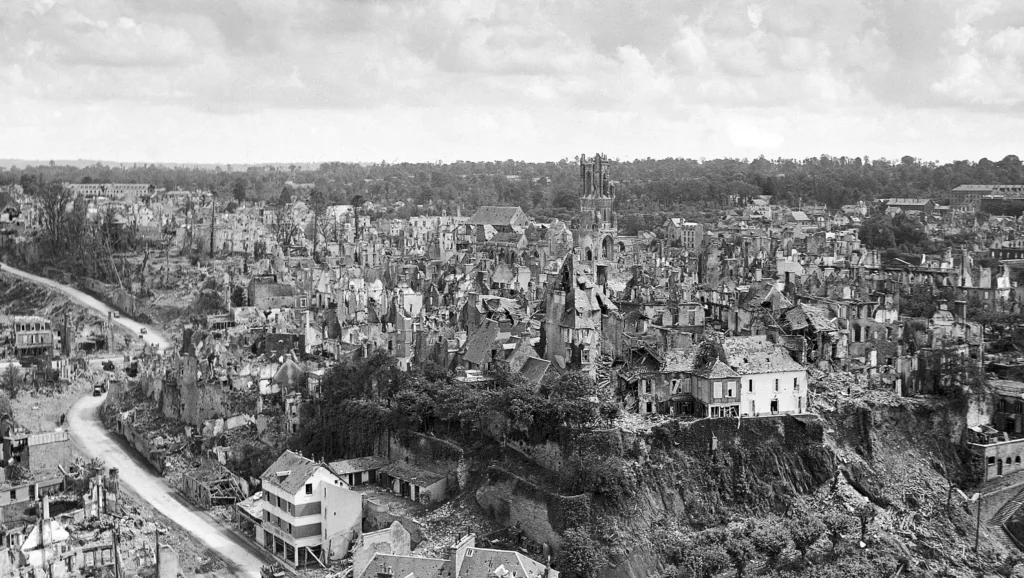
American soldiers had to get creative, welding metal prongs onto tanks (“Rhino tanks”) to smash through the stubborn hedgerows.
The town had already suffered massive damage from Allied bombing in June 1944. By the time ground troops arrived, much of Saint-Lô was rubble—hence the grim nickname “The Capital of Ruins.”
American troops fought house to house, pushing through the wrecked streets against determined German defenders.
Aftermath and Liberation
After weeks of brutal combat, American troops finally liberated Saint-Lô on July 18, 1944. This victory opened the door for Operation Cobra—the American breakout from the Normandy beachhead.
The human cost was staggering. Both military and civilian casualties were high, and many of the town’s residents became victims of the fighting and bombing.
Almost 95% of Saint-Lô was in ruins after the battle. Of the town’s roughly 12,000 pre-war residents, only about 3,000 remained, many living in makeshift shelters amid the rubble.
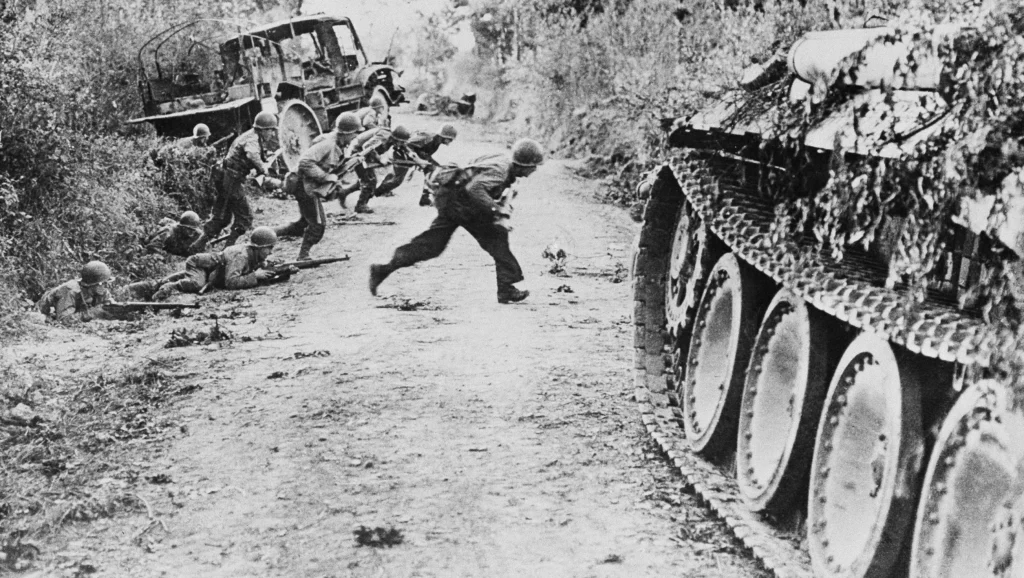
After liberation, Saint-Lô became a symbol of war’s destruction and the need for rebirth. The town was rebuilt in the post-war years, blending modern architecture with preserved historical elements that survived.
Memorials and markers around Saint-Lô now commemorate this pivotal battle and honor those who fought and died during this critical phase of World War II.
Role of Allied Forces in Saint-Lô’s Liberation
Freeing Saint-Lô took a coordinated push from multiple Allied armies, who faced tough German resistance in the tricky Norman hedgerows.
British Forces’ Contributions
British forces played a big part in liberating Saint-Lô during Operation Overlord and the Normandy campaign. After landing on D-Day (June 6, 1944), British troops pushed toward Saint-Lô from the north and northeast.
The British Second Army, especially XXX Corps, helped secure the areas around Saint-Lô. They battled through the dense bocage countryside—those hedgerows gave German defenders a real edge. British artillery and air power were key in weakening German positions around the town.
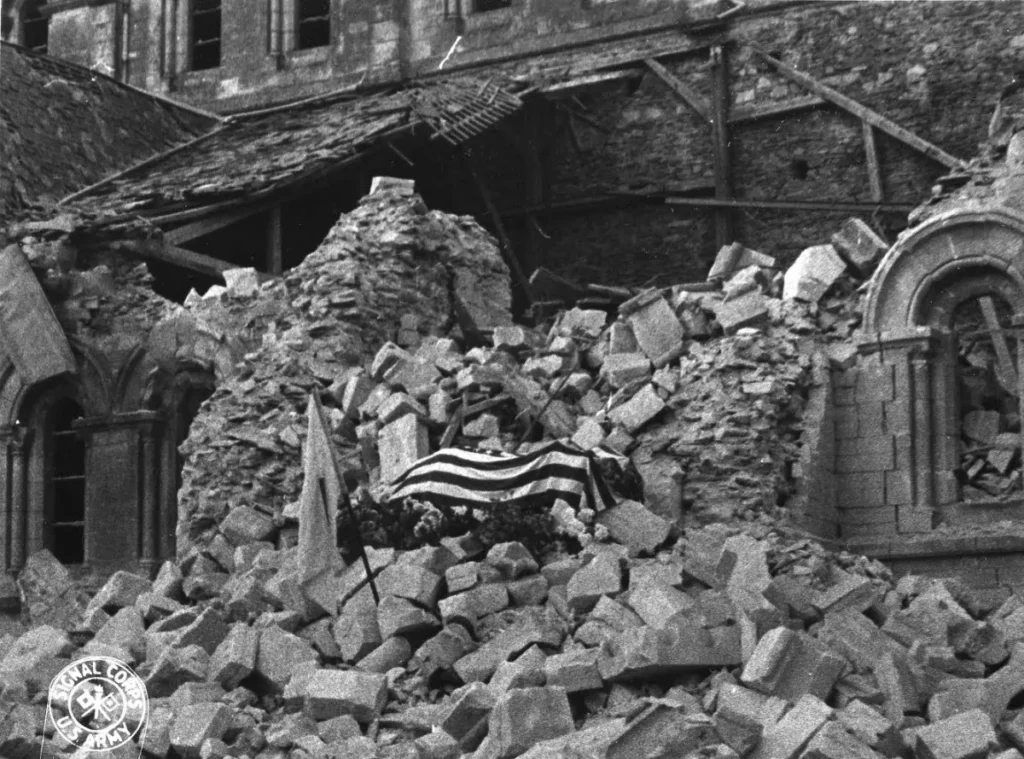
British intelligence and recon units mapped out German defenses, giving crucial info for the final advance into Saint-Lô. Their efforts included tying down German reinforcements that might have otherwise made the town even harder to take.
Canadian Forces’ Involvement
Canadian forces played a big part in the Saint-Lô campaign, working alongside the other Allies in Normandy. The 3rd Canadian Infantry Division hit the beaches at Juno on D-Day and pushed to secure the northern routes toward Saint-Lô.
It wasn’t easy going—Canadian troops ran into tough resistance in the hedgerows as they moved toward the town. They fought hard against German units, blocking reinforcements from reaching the Saint-Lô defenders.
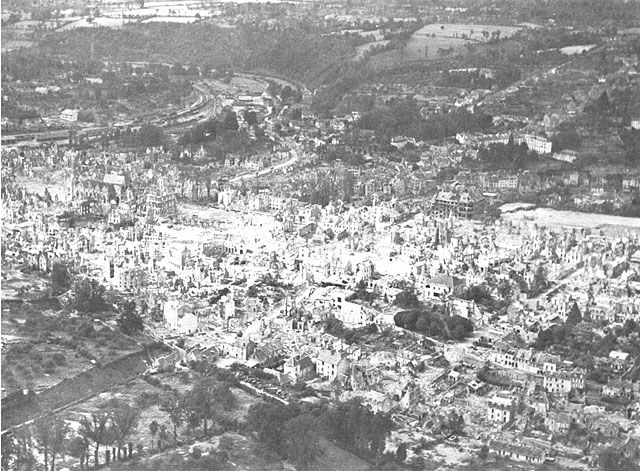
Canadian artillery backed up the Americans during their final drive into Saint-Lô, laying down fire that made a real difference. Their teamwork with other Allied forces really showed how international the whole campaign was.
By July 1944, the Allies had Saint-Lô pretty much surrounded, and American troops finally liberated the town on July 18. The Canadians’ push on the northern flank gave the Americans space to concentrate on the main assault.
Saint-Lô’s Key Sites and Monuments
Saint-Lô offers a mix of rebuilt landmarks and important WWII memorials. The city’s architecture tells a story of destruction and renewal, while monuments honor those who sacrificed during the Battle of Normandy.
Rebuilt Town Center and Landmarks
The Notre-Dame Church stands as Saint-Lô’s most recognizable landmark. Though WWII bombing heavily damaged it, its twin towers were painstakingly rebuilt and now dominate the skyline. You can climb the church tower for sweeping views of the town and countryside.
The Old Ramparts give a glimpse into Saint-Lô’s medieval past. These ancient walls survived the bombing better than most buildings and now provide a peaceful walking path overlooking the Vire River.
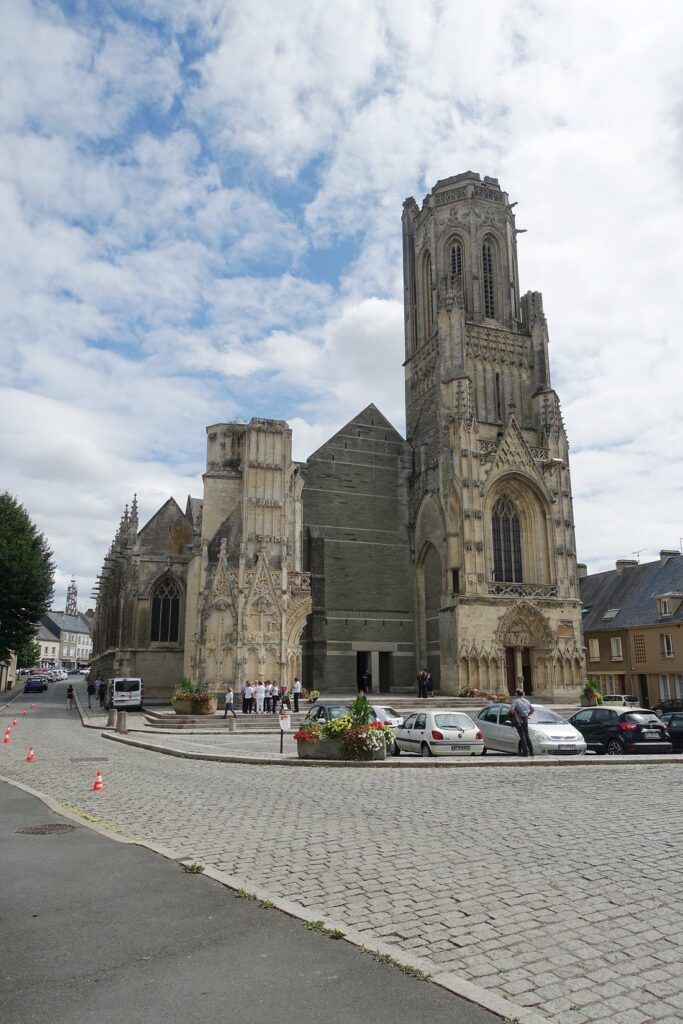
The Town Hall (Hôtel de Ville) shows off post-war reconstruction style. Built in the 1950s, it’s a testament to Saint-Lô’s resilience after nearly total destruction.
WWII Memorials
The Memorial to the Martyrdom of Saint-Lô, near the city center, honors the civilian victims of the 1944 bombings. The monument’s artwork depicts the suffering people endured during that period.
The Museum of Fine Arts includes a section on Saint-Lô during WWII. Photographs, artifacts, and personal accounts document the city’s destruction and its rebuilding.
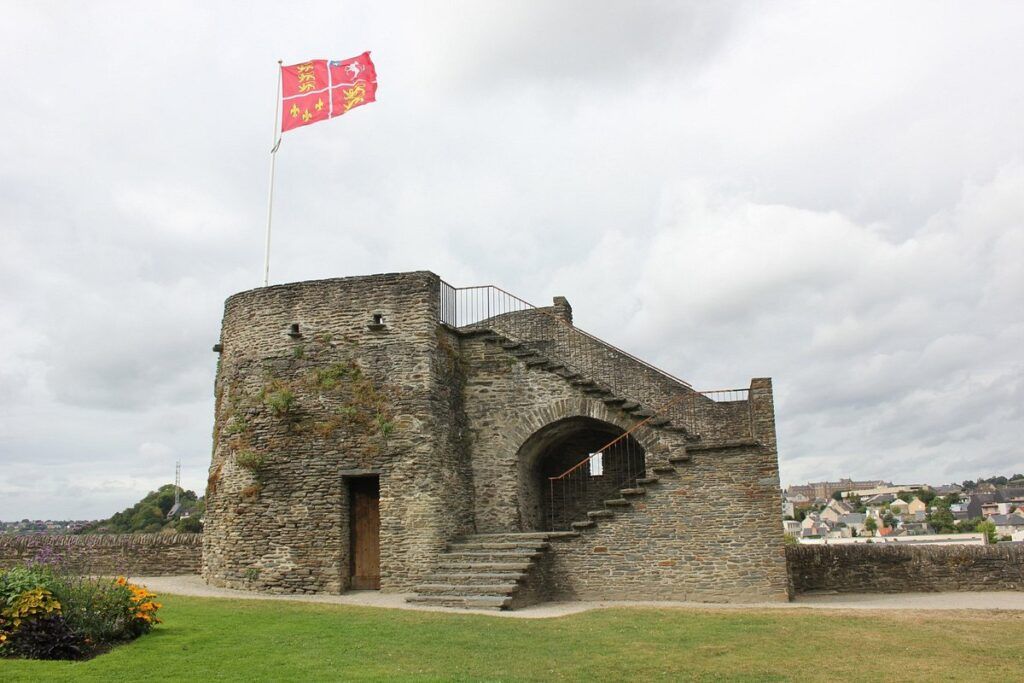
The Green Path (Voie Verte) follows the old railway line where American forces advanced during the Battle of Normandy. Information panels along the way explain key events from the campaign.
Monuments and War Cemeteries
The American Memorial pays tribute to the U.S. forces who liberated Saint-Lô. Located at a strategic crossroads dubbed “The Capital of Ruins” by Samuel Beckett, this monument marks where Allied forces broke through German defenses.
The German Military Cemetery at Marigny, near Saint-Lô, holds the graves of over 11,000 German soldiers. It’s a somber place that offers a different view on the war’s human cost.
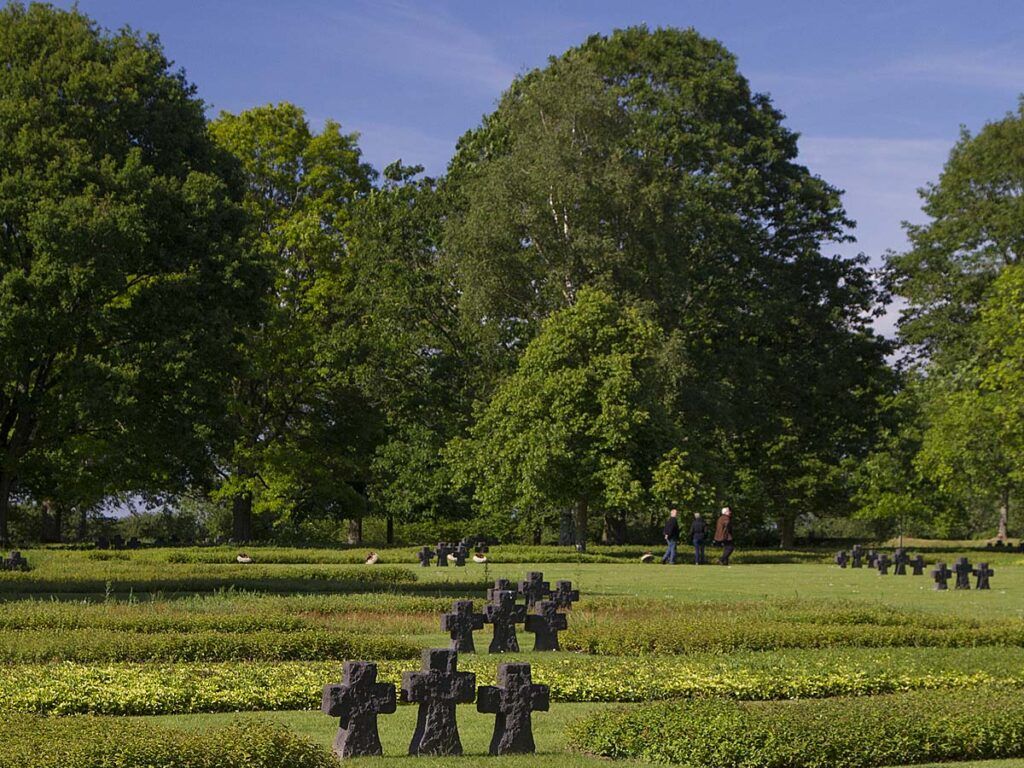
The Saint-Lô War Memorial in Place du Champ de Mars honors local resistance fighters. The simple stone monument lists the names of those who fought against occupation and marks key dates in the city’s liberation.
Museums and Educational Centers
Saint-Lô has several museums and educational resources that help visitors understand the town’s pivotal role in World War II. These places preserve important artifacts and documents while giving context about the Battle of Normandy and its impact on the region.
World War II Exhibitions
The Musée du Bocage Normand covers how the war changed rural Norman life. You’ll find displays of everyday items alongside military gear from the battle for Saint-Lô.
The Memorial de Saint-Lô houses a big collection of photographs, weapons, and personal items from soldiers who fought in the area. English audio guides explain the strategic importance of “The Capital of Ruins” during the Allied advance.
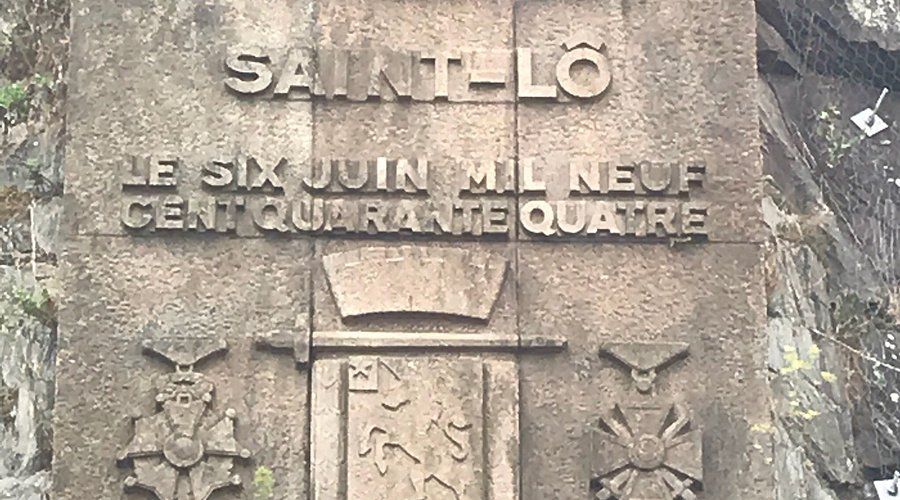
Don’t skip the small but fascinating Liberation Museum, which focuses on the American forces that liberated the town in July 1944. It features interactive displays showing the battle’s progression and first-person accounts from both soldiers and civilians.
Historical Archives and Resources
The Archives Départementales de la Manche in Saint-Lô holds records and documents from the occupation and liberation periods. With advance notice, you can access military records, resistance movement documents, and civilian accounts.
The Centre de Documentation helps researchers and curious visitors with digitized newspapers, photographs, and military maps from the Battle of Normandy. The staff can help you find info about specific units or events.
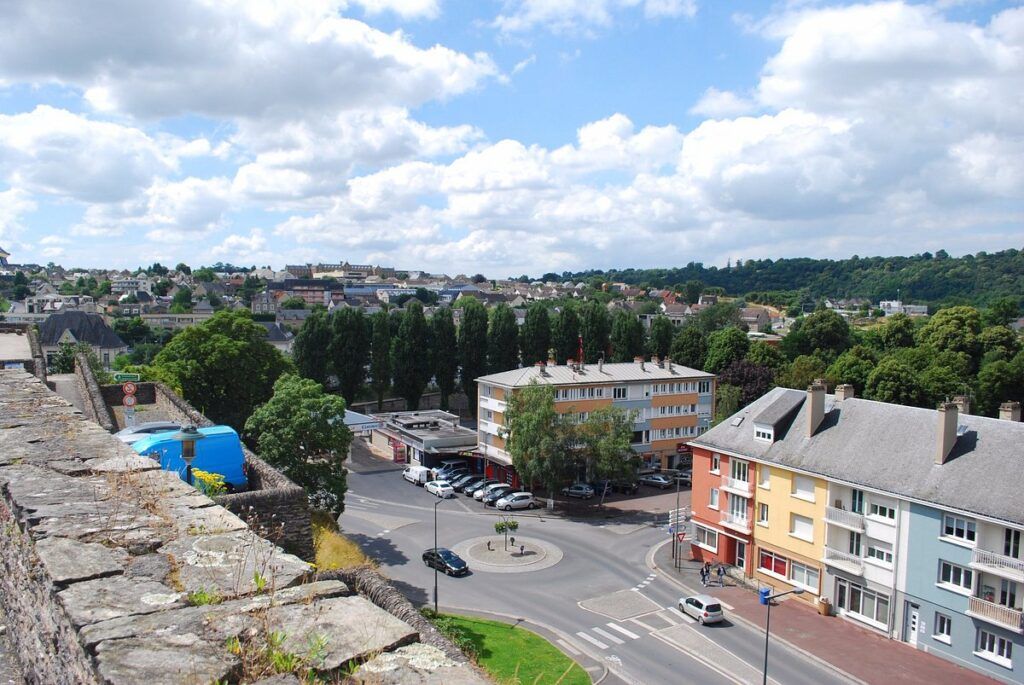
Local libraries keep Oral History Collections with recorded interviews from residents who lived through the bombing and rebuilding of Saint-Lô. These personal stories give perspectives you won’t find in official histories.
Nearby D-Day Landing Beaches and Sites
Saint-Lô’s central location makes it a great base for exploring Normandy’s historic D-Day sites. The American landing beaches of Utah and Omaha are both within a 45-minute drive, offering powerful reminders of the Allied invasion that began on June 6, 1944.
Utah Beach
Utah Beach is about 35 miles (56 km) north of Saint-Lô. This was the westernmost landing site during Operation Overlord, where the U.S. 4th Infantry Division landed. Today, you’ll find the Utah Beach Museum with authentic aircraft, vehicles, and interactive displays explaining the invasion plan.
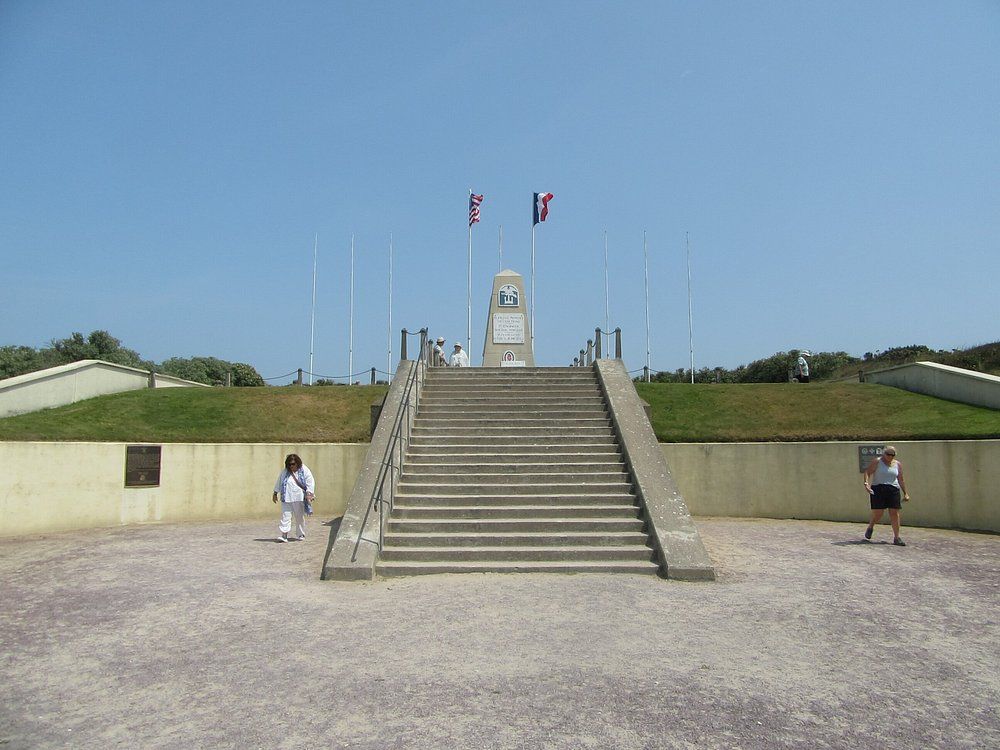
The wide, open beach itself hasn’t changed much since 1944. Look for monument markers and German bunkers still visible along the shore.
It’s less crowded than other D-Day sites, so you get space to reflect. Try visiting in the early morning—there’s often mist and a peaceful vibe that’s hard to describe.
Omaha Beach
Omaha Beach, about 30 miles (48 km) from Saint-Lô, saw the heaviest American casualties on D-Day. This 5-mile stretch of coastline was a brutal battleground where U.S. forces faced steep cliffs and tough German defenses.
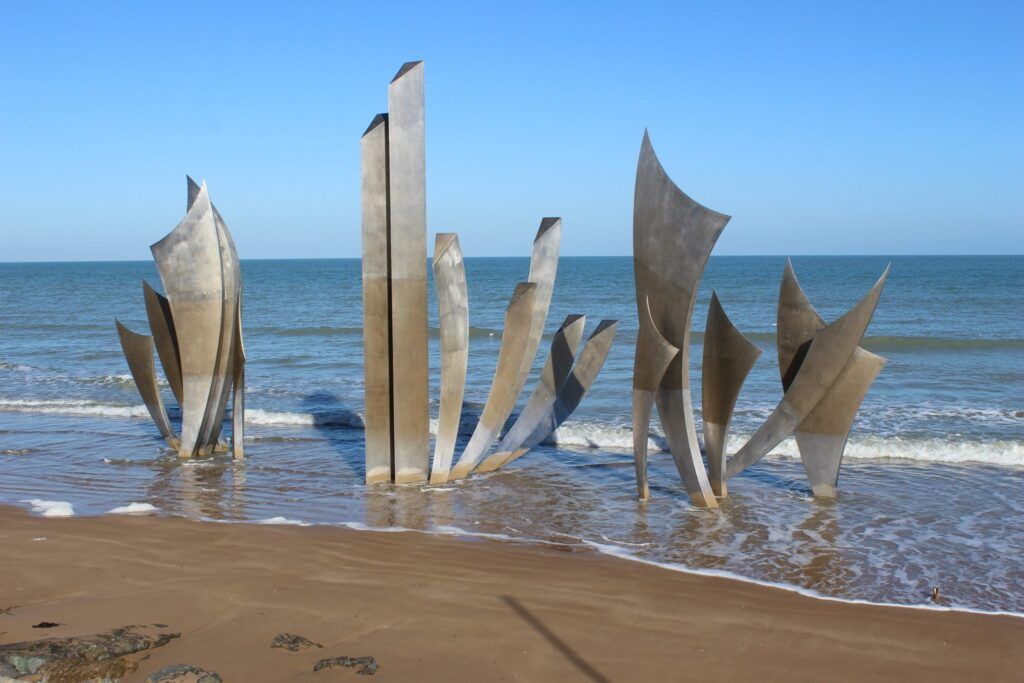
The American Cemetery overlooking the beach contains 9,388 white marble crosses and Stars of David. The rows of perfectly aligned headstones deliver a powerful visual reminder of the cost of war.
Be sure to visit the Overlord Museum near the cemetery, which has an impressive collection of tanks and military vehicles. The beach itself is peaceful now, but memorial markers and old bunkers help you picture the events of June 6, 1944.
Exploring the Cotentin and Cherbourg Peninsulas
The Cotentin Peninsula gives visitors a unique mix of rugged coastlines and rich WW2 history. This area played a big part during the D-Day operations and the later Battle of Normandy.
Stay steps from Omaha Beach and historic landmarks. Best rates on local accommodations.
Cherbourg’s Historical Significance
Cherbourg was a key military objective after the D-Day landings. American forces went after this major port because the Allies needed it to supply their troops. On June 26, 1944, American soldiers took Fort du Roule, which was a big win.
Cherbourg became the first major port in mainland France to be liberated during the campaign. Its deep-water harbor made it strategically vital. If you’re curious about the city’s wartime past, the Liberation Museum is worth a visit.
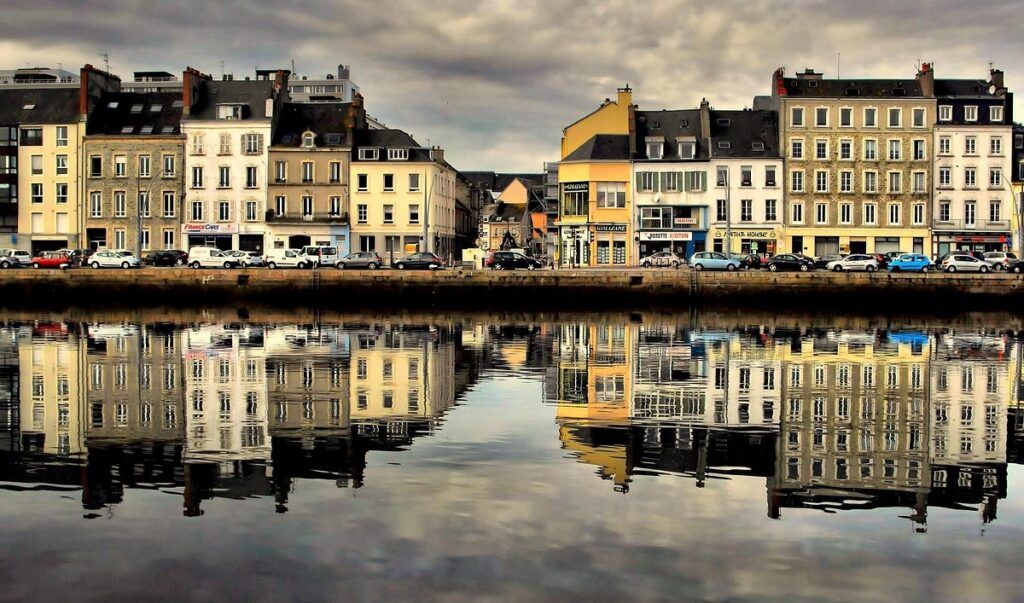
When you’re in Cherbourg, consider stopping at:
- Fort du Roule (now home to the Liberation Museum)
- The Maritime Museum
- The old German coastal defenses
Pegasus Bridge and Surrounding Areas
Pegasus Bridge stands out as one of D-Day’s most daring stories. East of the main Cotentin landing zones, British airborne troops seized this crucial crossing in the early hours of June 6, 1944.
This move blocked German reinforcements from reaching the beaches. Today, you can check out the Pegasus Memorial Museum, which has the original bridge. The café nearby—the first French house freed during the invasion—is still there, too.
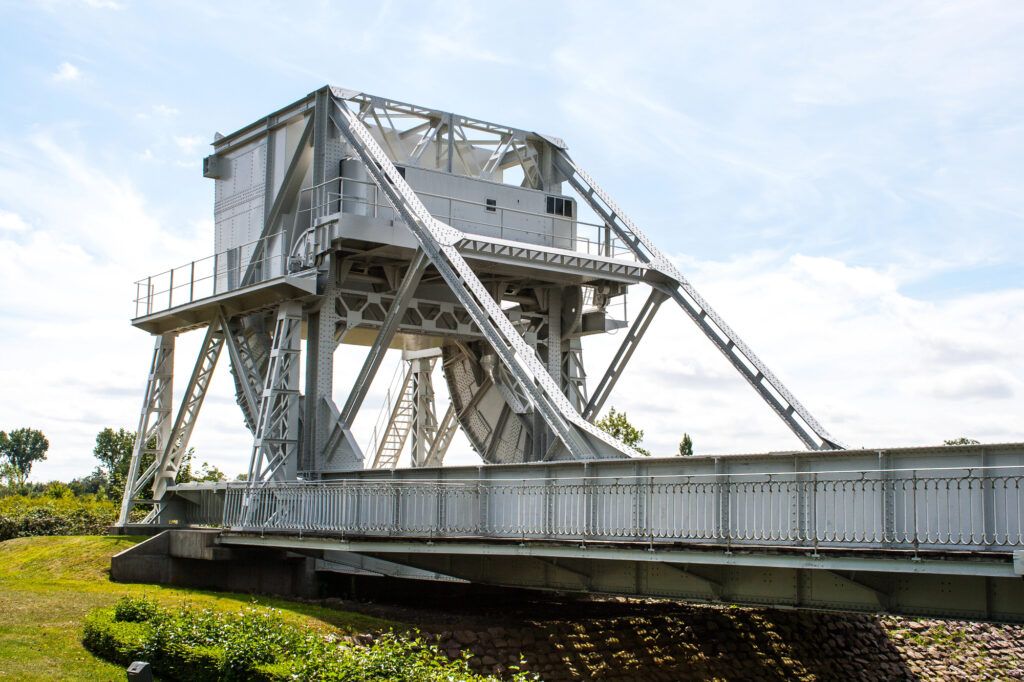
Some highlights in the area:
- The replacement bridge (the original sits at the museum)
- Gondree Café (first liberated building)
- The landing zones where gliders landed with impressive precision
You’ll spot plenty of info panels around, offering context about these pivotal D-Day moments.
Day Trips From Saint-Lô
Saint-Lô is a handy base for exploring Normandy’s layered history and culture. Several spots nearby let you dive into both medieval tales and World War II events.
Bayeux and the Bayeux Tapestry
Bayeux, just a half-hour from Saint-Lô, escaped the worst of WWII bombing, so its medieval character survived. The town’s main draw is the famous Bayeux Tapestry, a 70-meter embroidered epic showing William the Conqueror’s 1066 invasion of England.
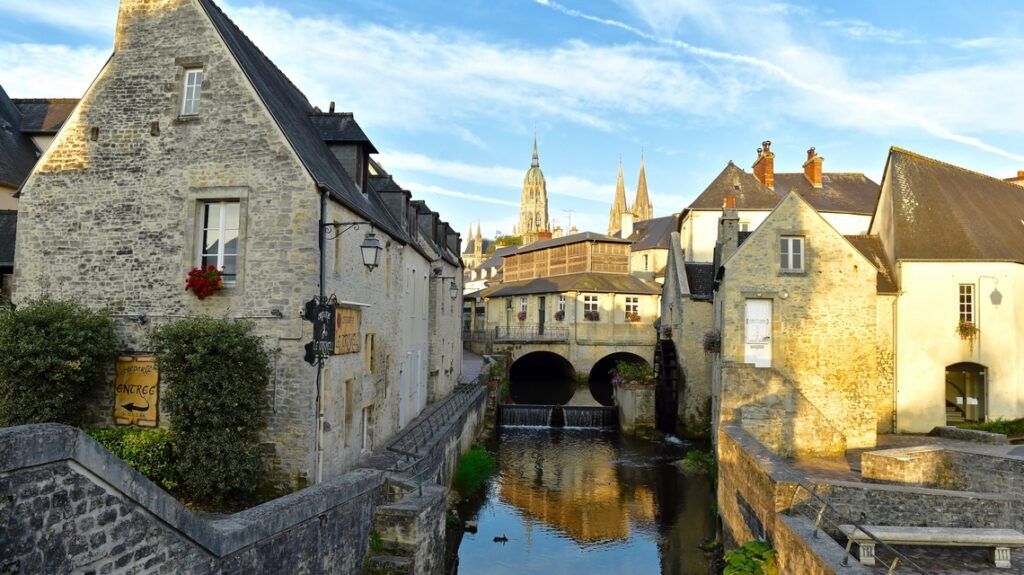
You can see the tapestry up close at its dedicated museum. Audio guides help unravel the story woven into each scene.
Besides the tapestry, Bayeux boasts the impressive Notre-Dame Cathedral, which dates back to the 13th century. The town is also a launch point for D-Day beach tours, with plenty of options departing daily.
Local restaurants serve up traditional Norman fare, so it’s worth sticking around for lunch after your museum visit.
Recommended D-Day Tours from Bayeux:
- From Bayeux: American D-Day Sites in Normandy Full-Day Tour
- From Bayeux: American D-Day Sites in Normandy Half-Day Tour
- From Bayeux: Half-Day Normandy WWII Sidecar Tour
- Full-Day US Battlefields of Normandy Tour from Bayeux
Caen Memorial
The Caen Memorial is about 45 minutes from Saint-Lô and is widely considered one of Europe’s top WWII museums. This modern spot covers the Battle of Normandy and broader wartime history.
Inside, you’ll find personal stories, artifacts, and multimedia that bring the war years to life. One section focuses on D-Day, connecting the dots to Saint-Lô’s liberation.
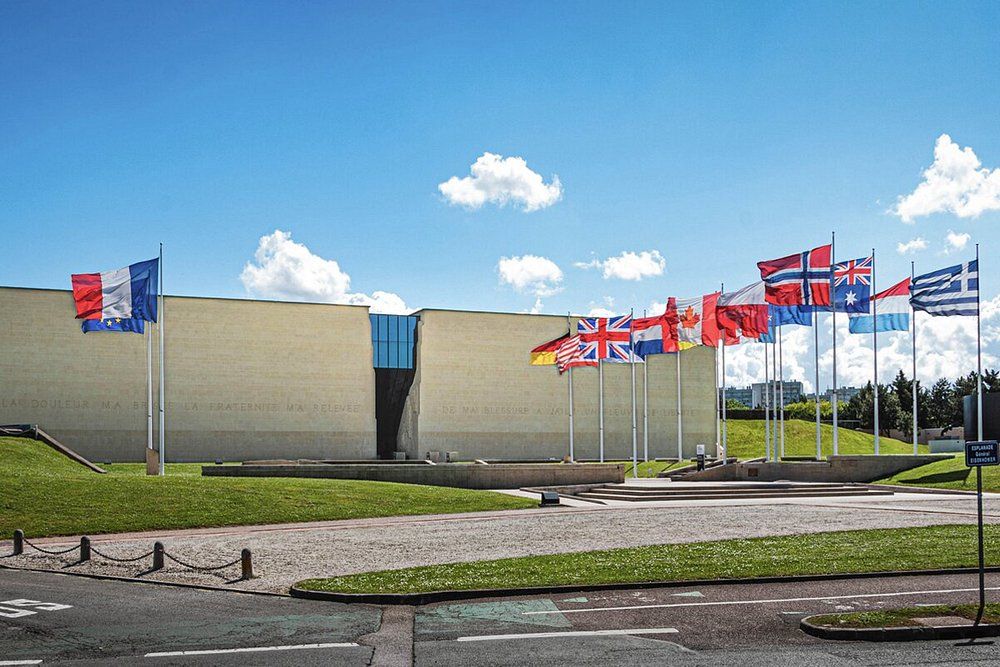
The museum also touches on the Cold War and features a peace gallery reflecting on post-war reconciliation.
Give yourself at least 3-4 hours to take it all in. There’s a restaurant and bookshop, too, if you’re hunting for Normandy-related reading material.
Commemorative Events and Remembrance Activities
Saint-Lô organizes several heartfelt events each year to honor those who fought in the Battle of Normandy and the D-Day invasion. These moments let visitors connect with history through ceremonies and learning experiences.
Find the perfect base for exploring Utah Beach, Pointe du Hoc, and beyond.
Annual D-Day Ceremonies
Every June, Saint-Lô holds commemoration ceremonies to mark D-Day and the Battle of Normandy. The main gathering happens on June 6th at the city’s war memorial, with veterans (when they’re able), military reps, and local leaders attending.
For 2024, the 80th Anniversary celebrations were a big deal, with expanded programs focused on peace, liberty, and reconciliation. These events include:
- Military parades downtown
- Wreath-laying at key memorials
- Moments of silence for the fallen
- Special exhibits of wartime artifacts and photos
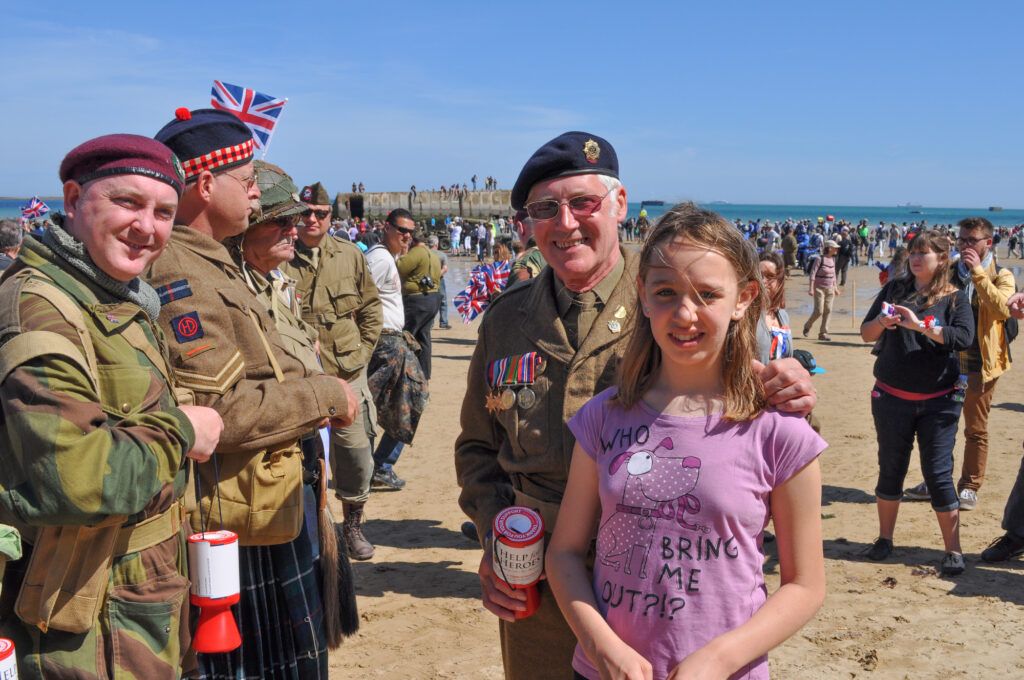
Local schools often join in by singing national anthems and reading stories from Saint-Lô’s liberation.
Educational and Guided Tours
You can join guided tours that retrace the Allied advance through Saint-Lô in 1944. These run year-round, with more options in summer.
Popular tours include:
- Walking tours of battle sites with certified guides
- Museum visits with focused talks on the Allied invasion
- “Liberation Route” bus tours linking Saint-Lô to the D-Day beaches
- Interactive exhibits at the Saint-Lô History Museum, featuring battle artifacts
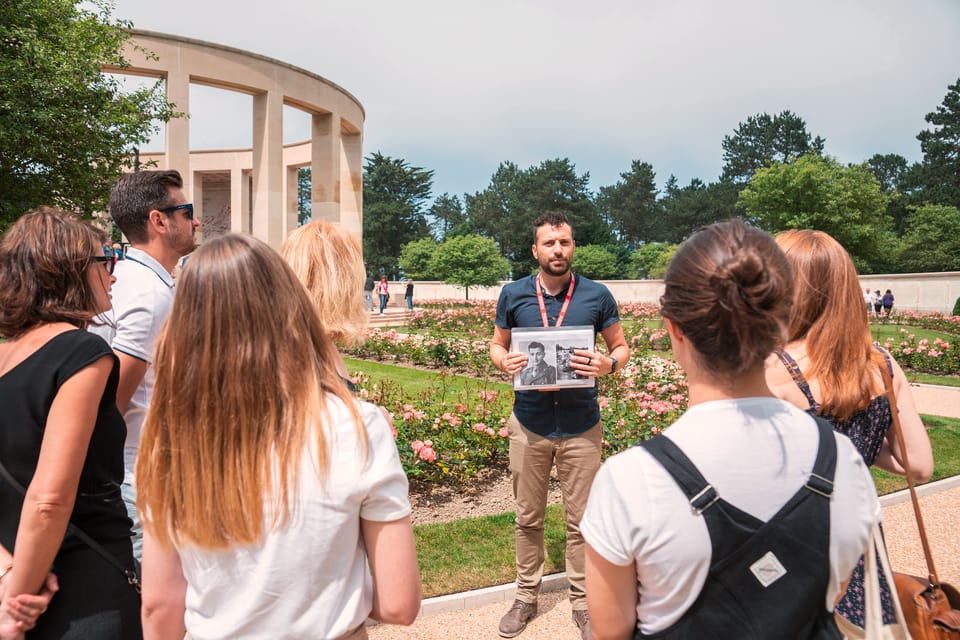
Many tours share firsthand accounts and letters from soldiers who fought here. For students and families, there are hands-on activities about wartime life and the city’s rebuilding after being almost completely destroyed during the fighting.
Recommended D-Day Tours from Bayeux:
- From Bayeux: American D-Day Sites in Normandy Full-Day Tour
- From Bayeux: American D-Day Sites in Normandy Half-Day Tour
- From Bayeux: Half-Day Normandy WWII Sidecar Tour
- Full-Day US Battlefields of Normandy Tour from Bayeux
Visitor Information and Practical Tips
If you’re planning a trip to Saint-Lô, it helps to know the basics about getting there and where to stay. The town’s accessible by several transport options and has lodging for most budgets.
See all available accommodations near Saint-Lô.
Getting to Saint-Lô
Saint-Lô sits in Normandy’s Manche department, roughly 300 km west of Paris. You can take a train from Paris Gare Saint-Lazare to Caen, then hop on a regional train to Saint-Lô. The whole trip takes about 3-4 hours.
Driving? Take the A13 from Paris to Caen, then the N174 to Saint-Lô. Expect about 3.5 hours on the road.
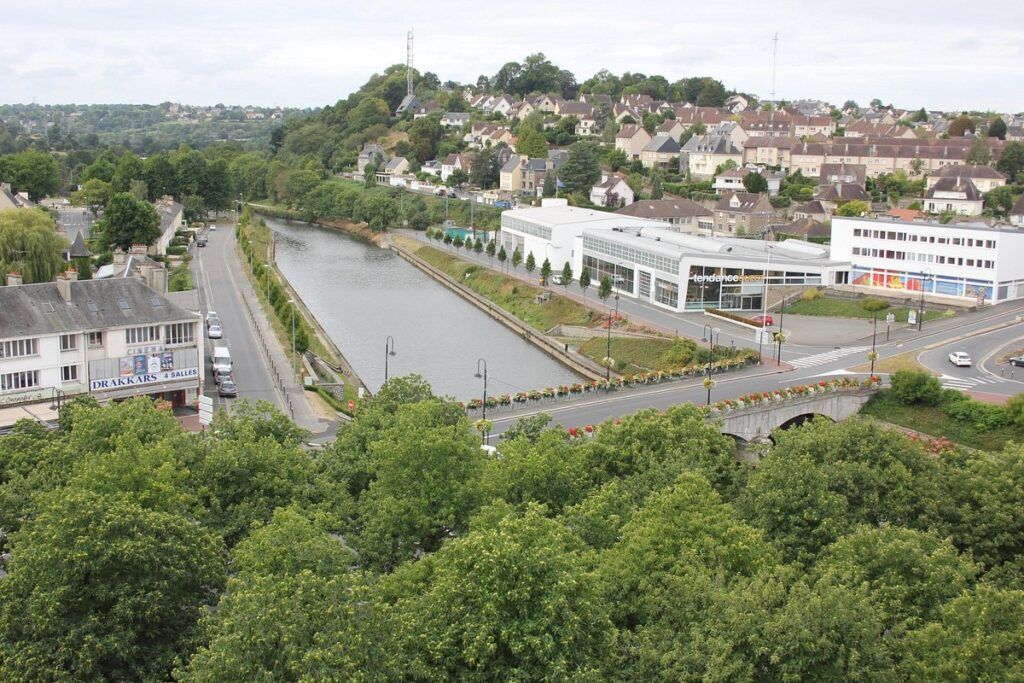
Buses connect Saint-Lô to nearby Normandy towns and D-Day sites, with SNCF buses running from Bayeux and other hubs.
If you’re flying in, the closest airports are in Caen (70 km) and Cherbourg (80 km). From there, you’ll need ground transport to reach Saint-Lô.
See all available accommodations near Saint-Lô.
Local Accommodations
Saint-Lô has a range of places to stay for different budgets. You’ll find several mid-range hotels in the center, like Hôtel Mercure and Hôtel La Croix d’Or, both within walking distance of the main sights.
Budget travelers can pick from small family-run guesthouses and B&Bs, which often serve breakfast with local Norman flavors.
If you’re coming during summer or around the D-Day anniversary in June, book early—those dates get busy fast.
Most hotels in Saint-Lô have free parking, handy if you’re exploring by car. Some even rent out bikes for getting around town.
See all available accommodations near Saint-Lô.
Present Day Saint-Lô: Culture and Community
Since WWII, Saint-Lô has reinvented itself as a lively cultural hub. Visitors today can enjoy the town’s strong equestrian roots, its music scene, and plenty of Norman traditions.
Find comfortable stays within moments of historic battlegrounds
Local Traditions and Festivals
Horses are at the heart of Saint-Lô’s identity. As “France’s horse capital,” the town regularly hosts horse shows and competitions at the National Stud Farm.
If you’re around in August, the “Normandie Horse Show” draws riders and fans from all over Europe. The week is packed with jumping, dressage, and breeding events.
Music’s a big deal, too. Le Normandy concert hall hosts local and international acts year-round, and it’s become a real cultural anchor for the area.
Every June, the town also honors its WWII history with liberation ceremonies. These events bring together locals and visitors to remember the sacrifices and resilience of earlier generations.
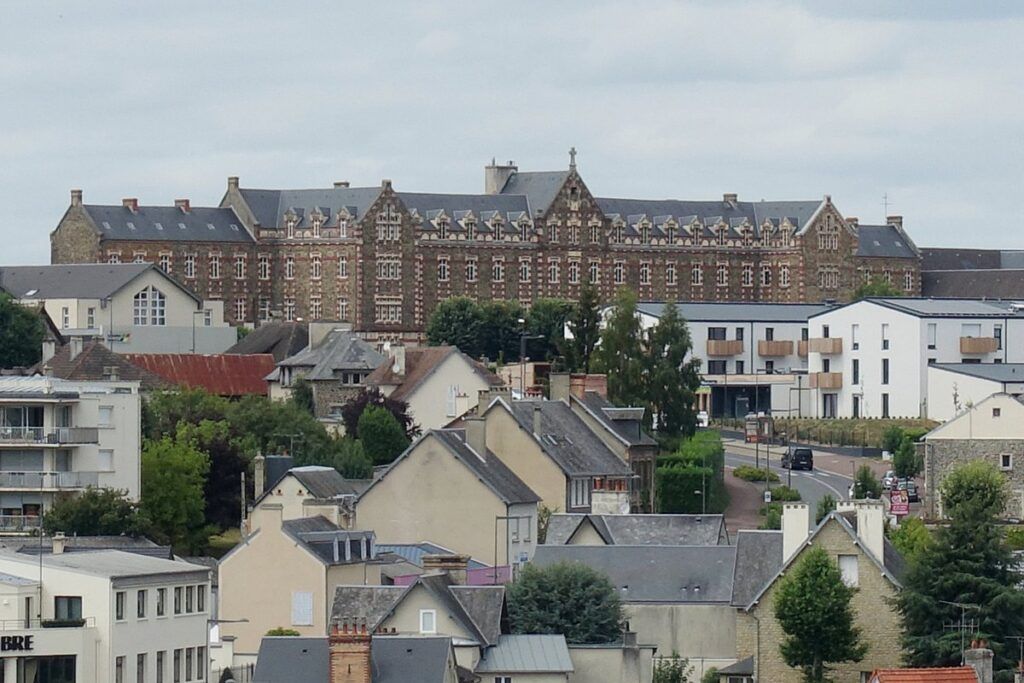
Gastronomy and Regional Cuisine
Norman food rules the scene in Saint-Lô, with lots of dairy, apples, and seafood on menus. You’ll find plenty of restaurants in the old town serving up these local flavors.
Local Specialties to Try:
- Normandy camembert and livarot cheeses
- Apple-based desserts and pastries
- Cider and calvados (apple brandy)
- Fresh seafood from nearby coasts
The weekly market in the town center is a great spot to taste regional products. Farmers bring fresh produce, cheeses, and handmade goods every Saturday morning.
Dining options range from casual bistros to more upscale places. Many focus on farm-to-table cooking, really showing off Normandy’s agricultural richness.
Local cider houses offer tastings and explain the traditional production process, which honestly hasn’t changed much in decades.
See all available accommodations near Saint-Lô.
From beachfront hotels to authentic French countryside stays. No booking fees.

